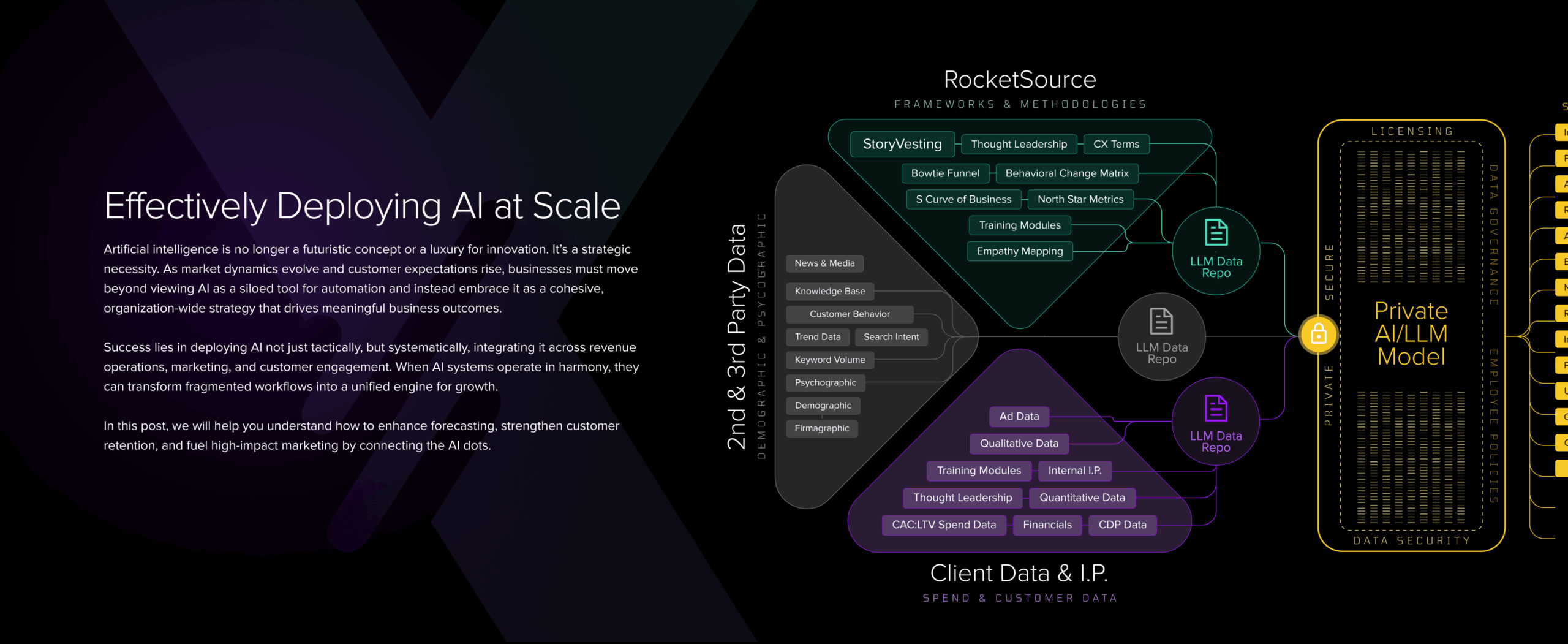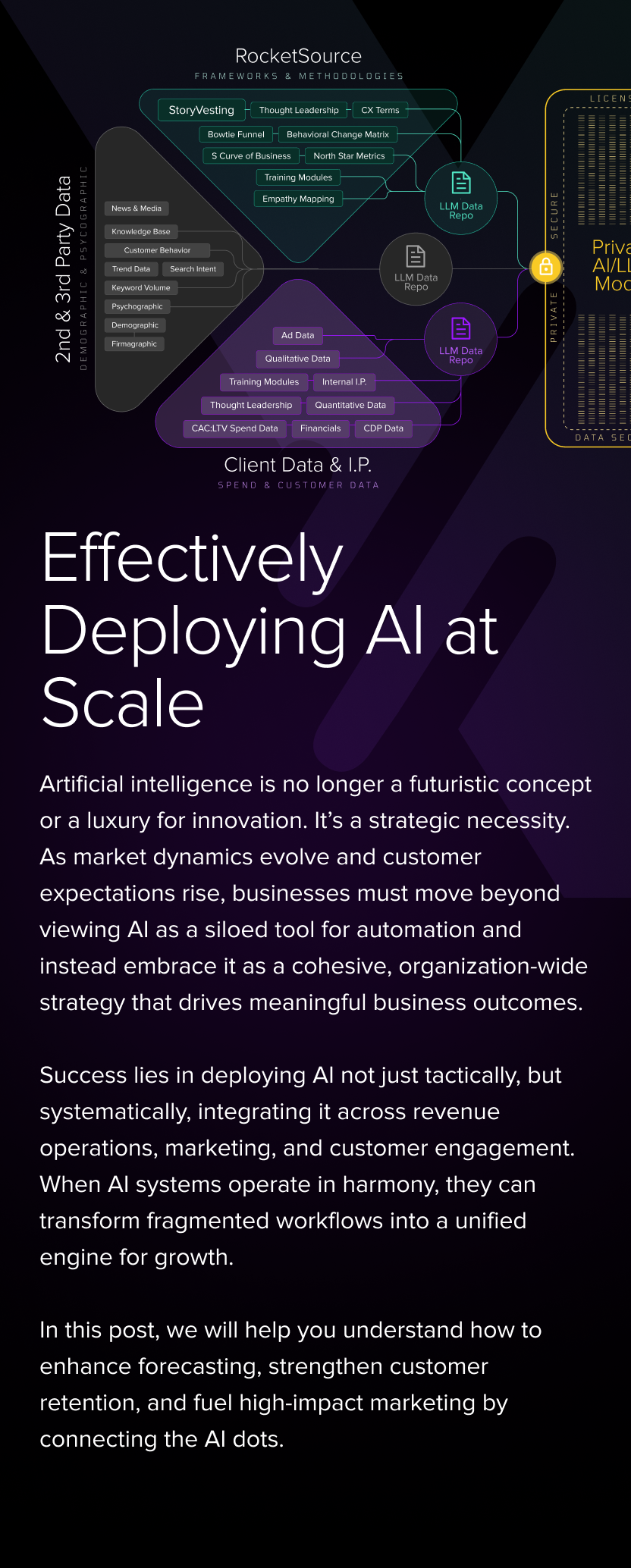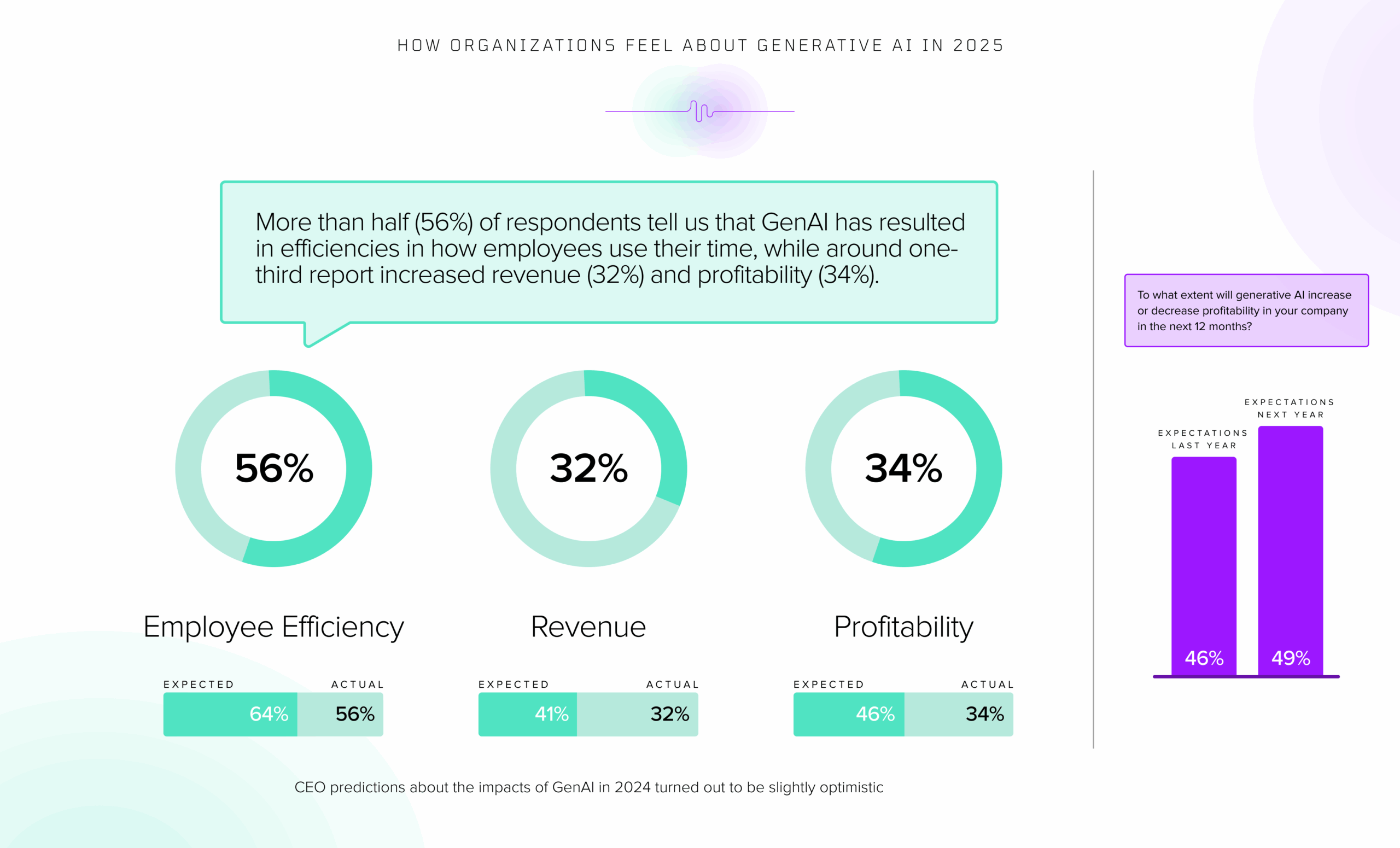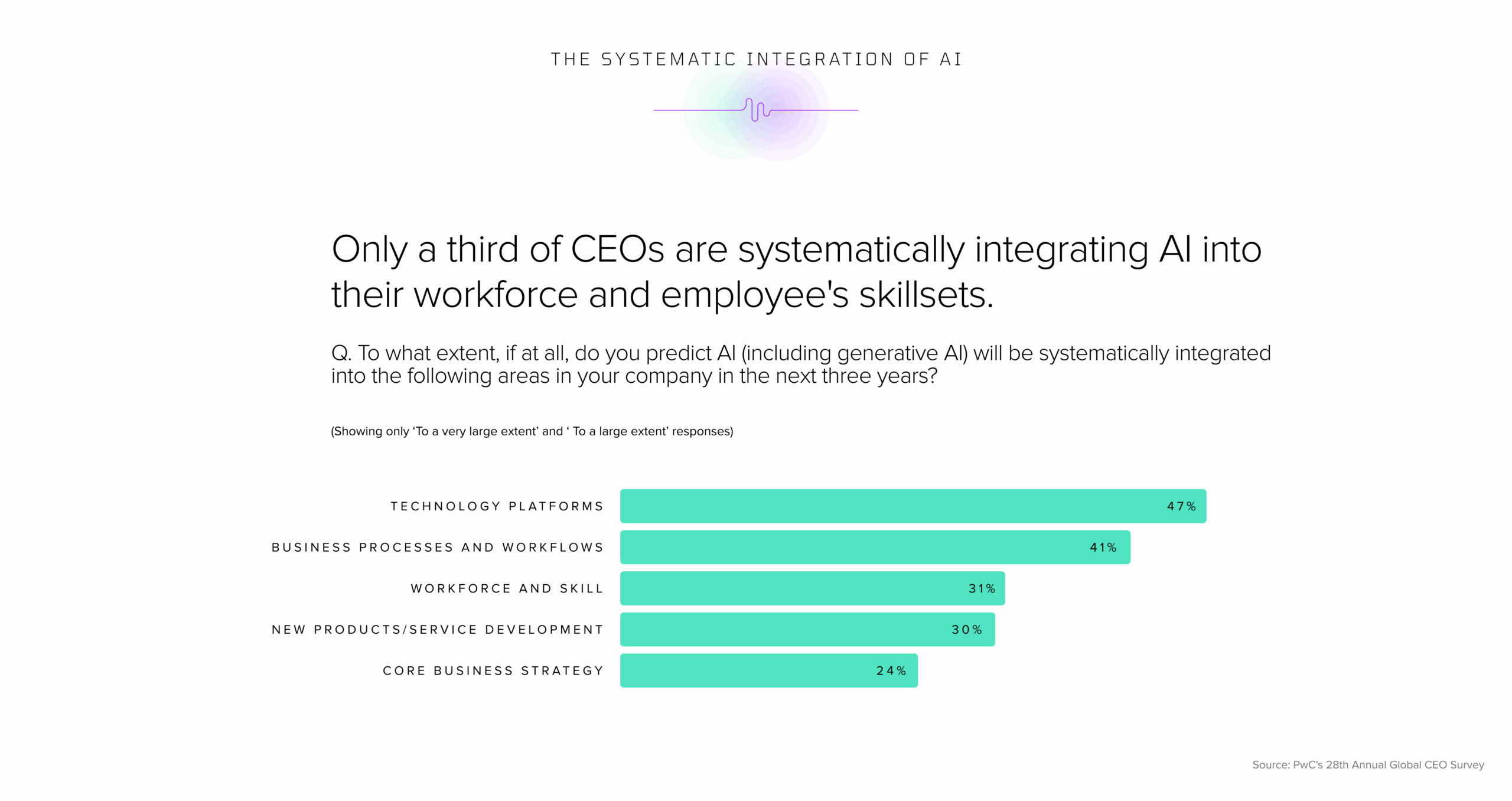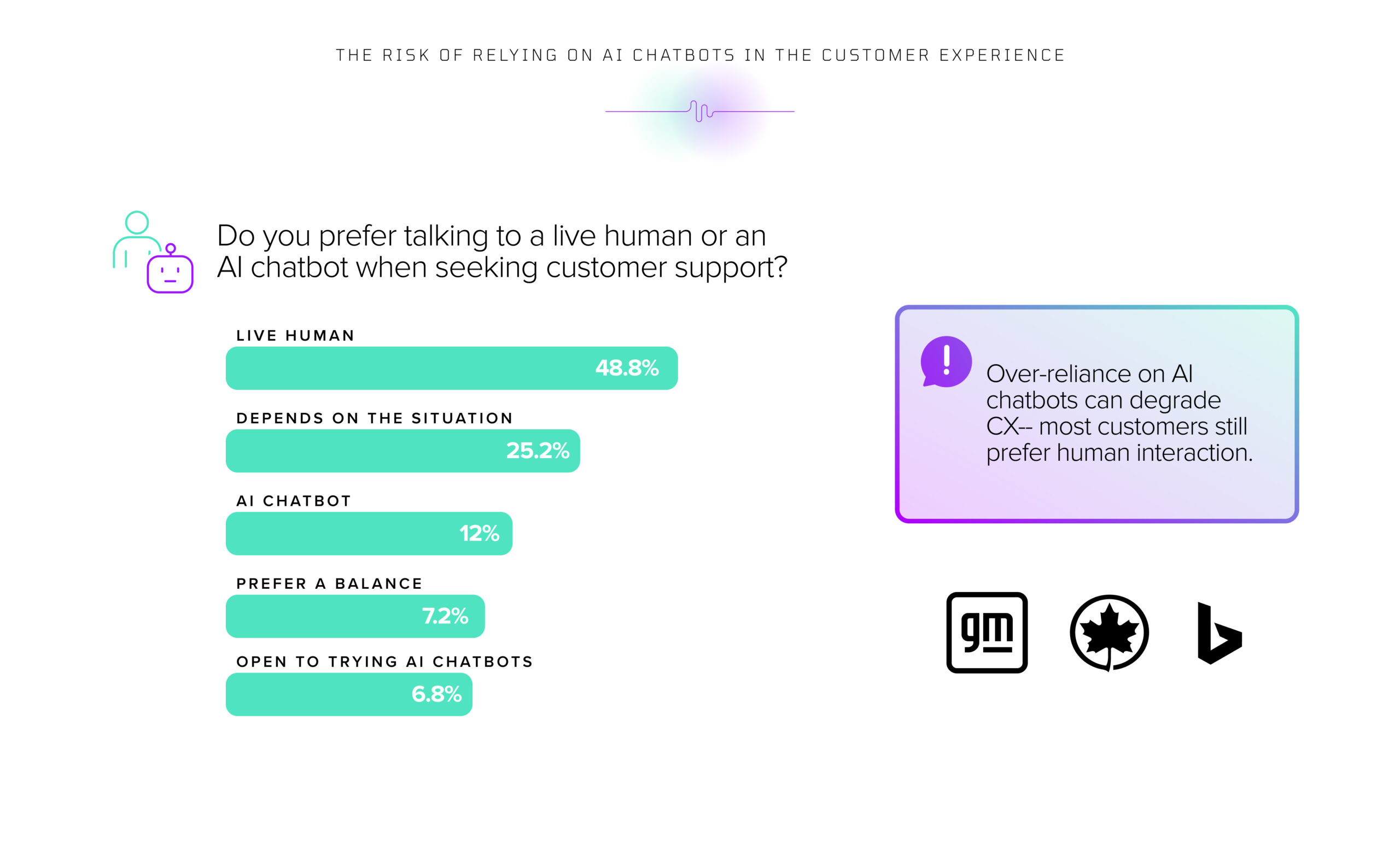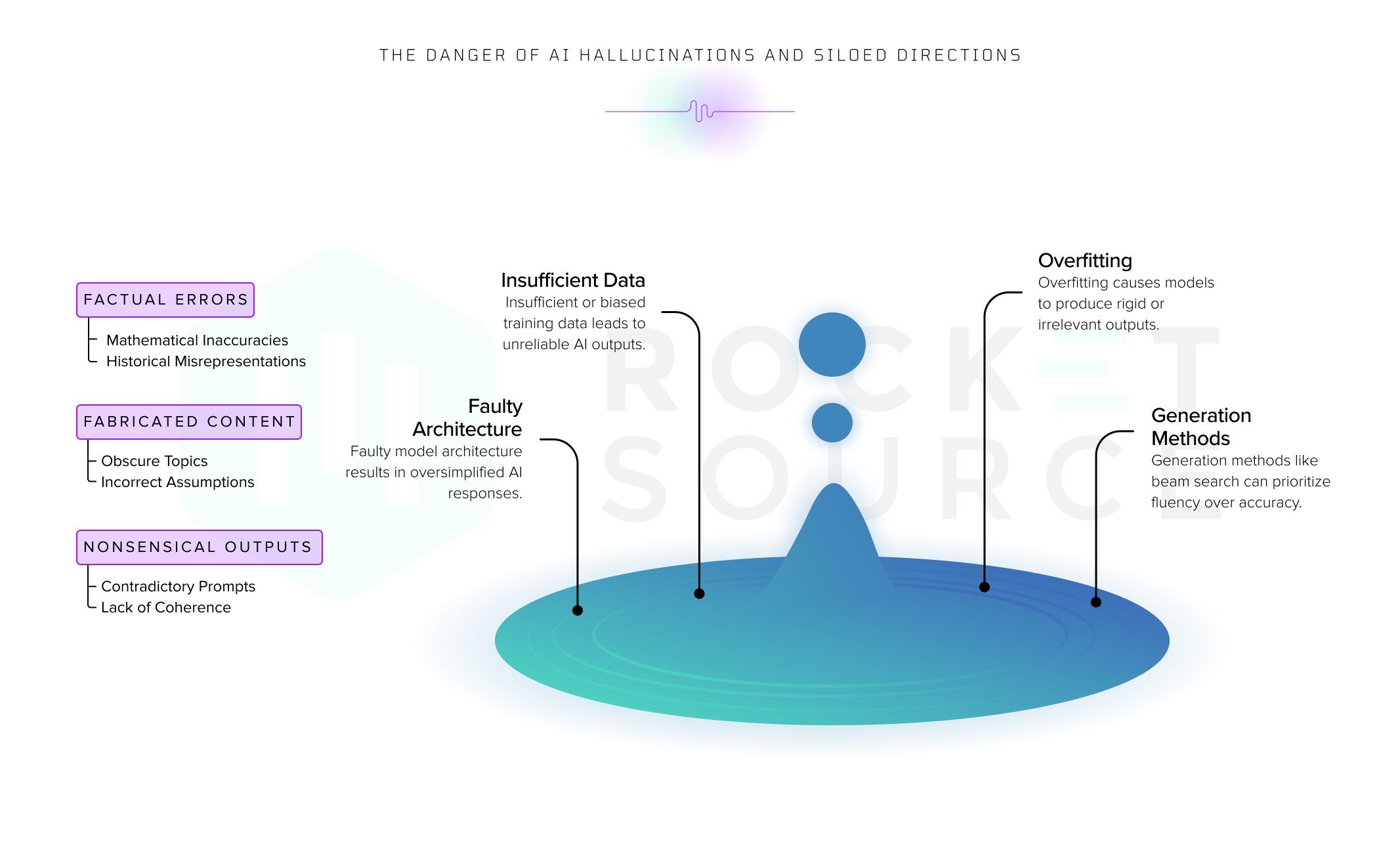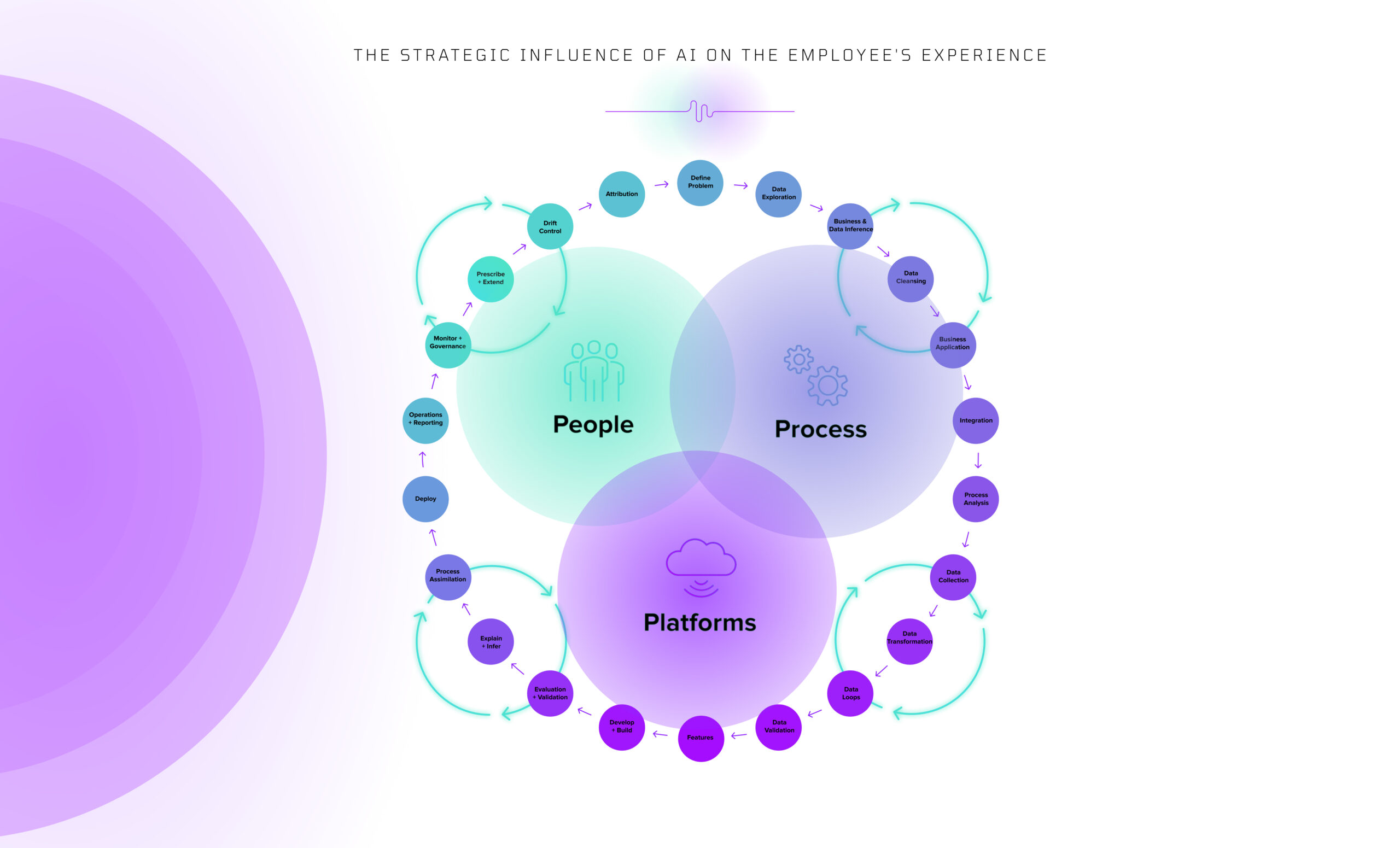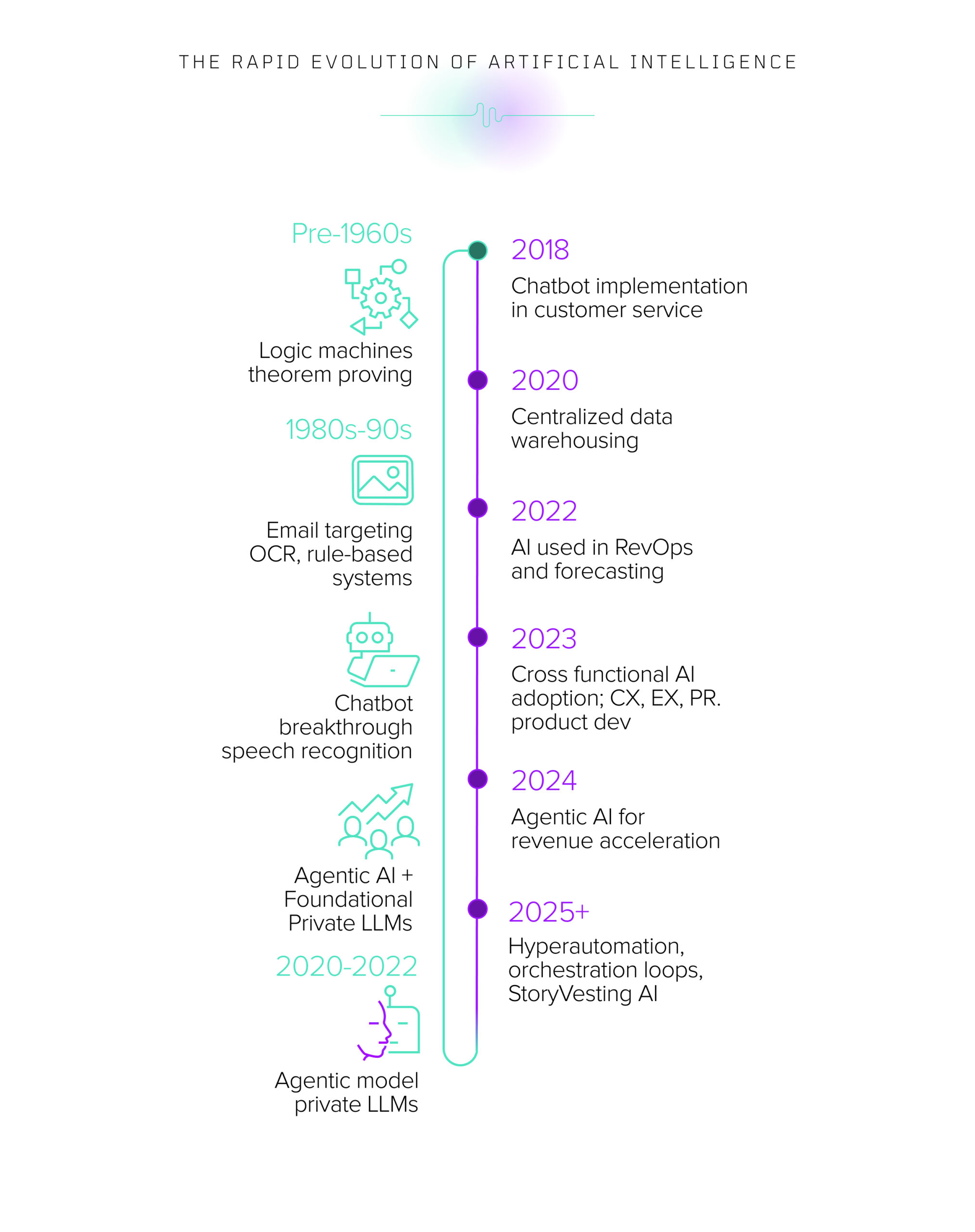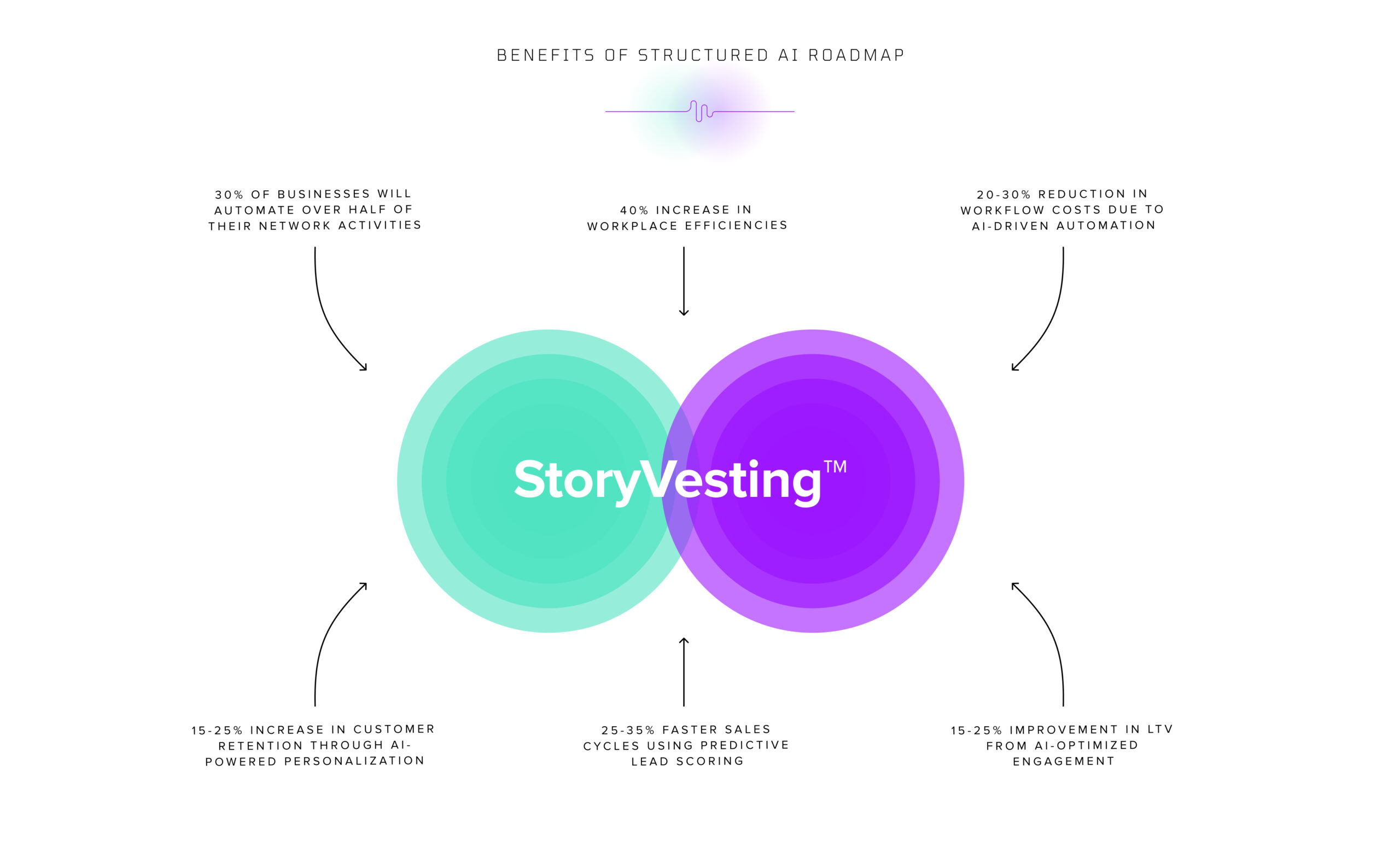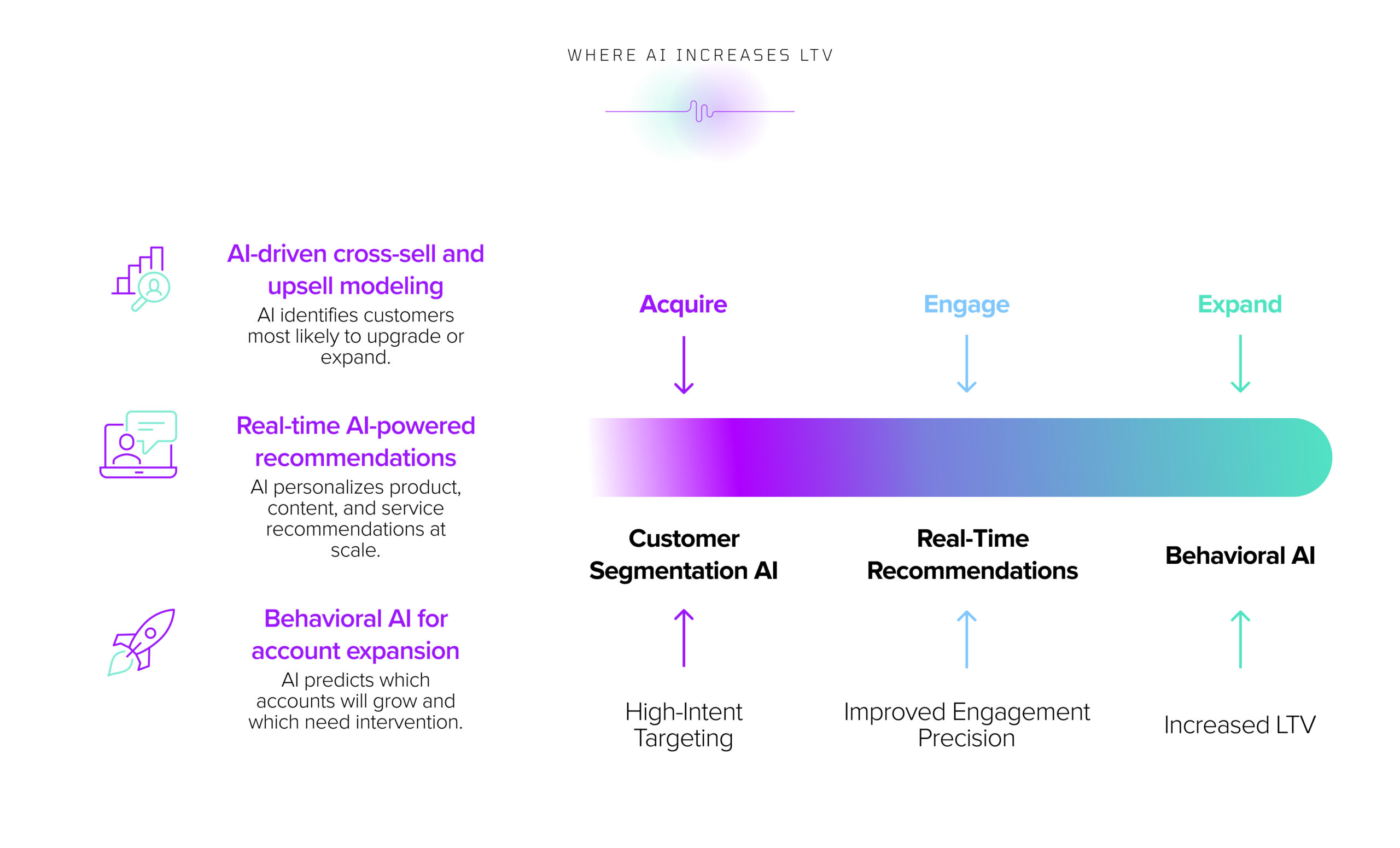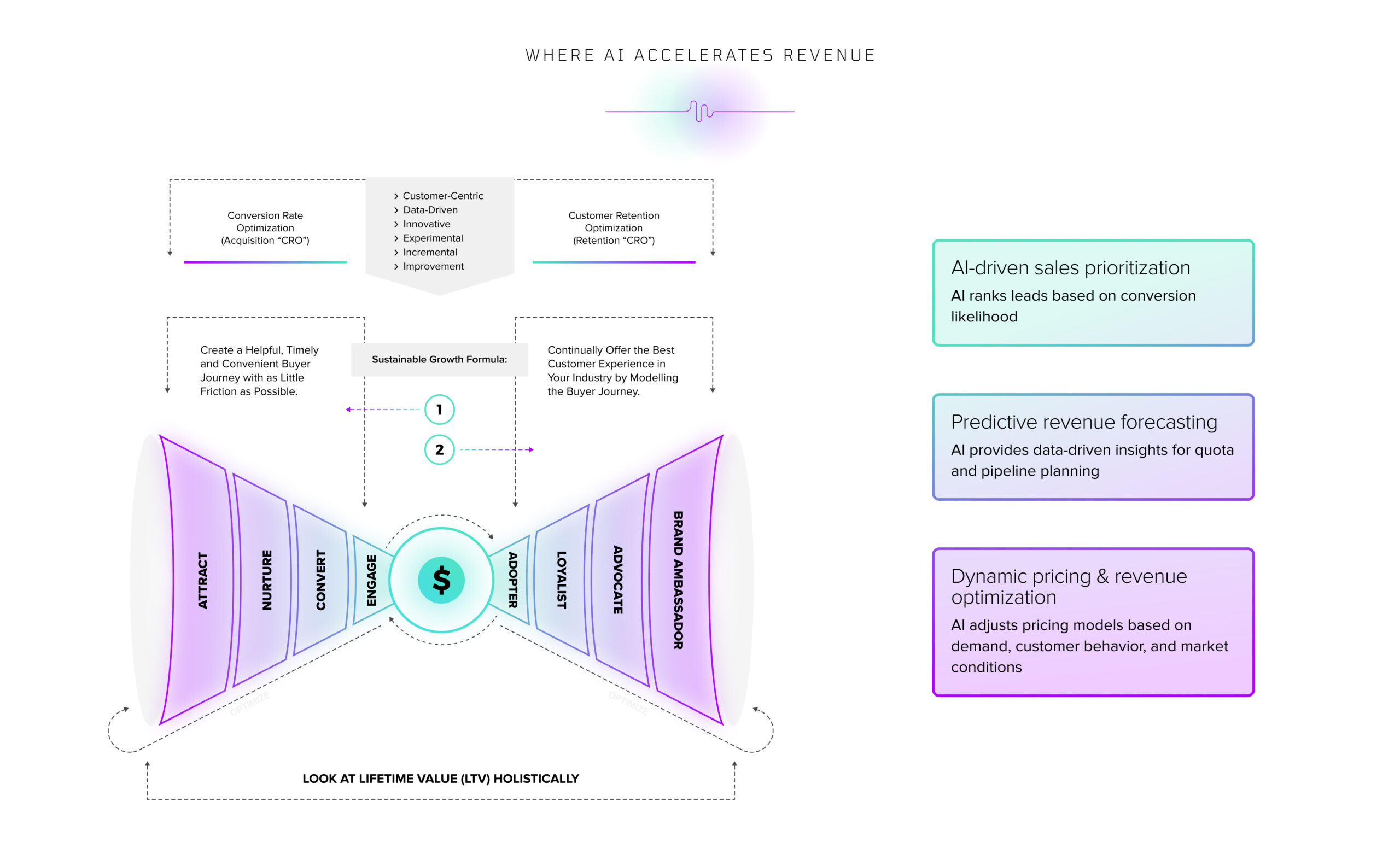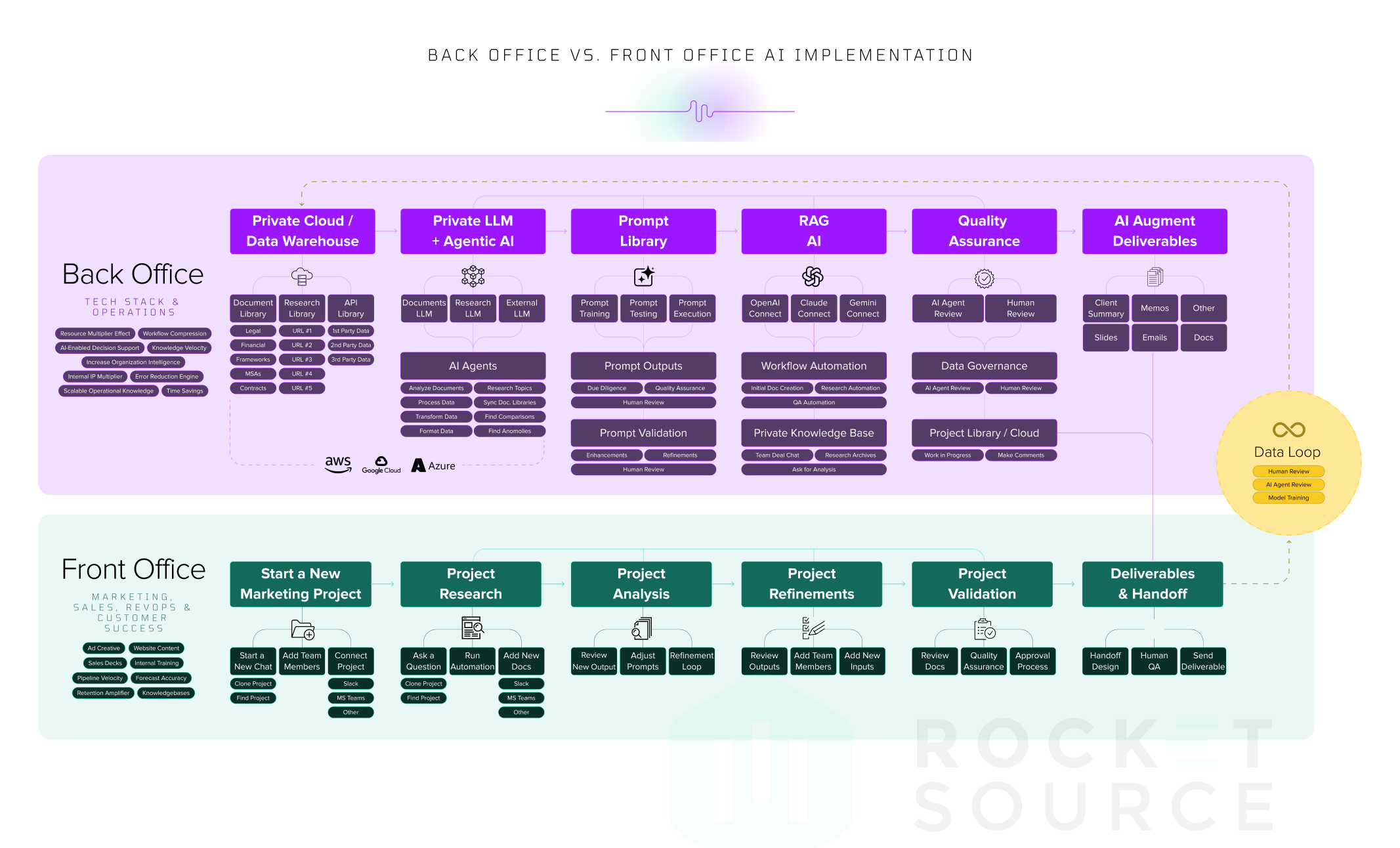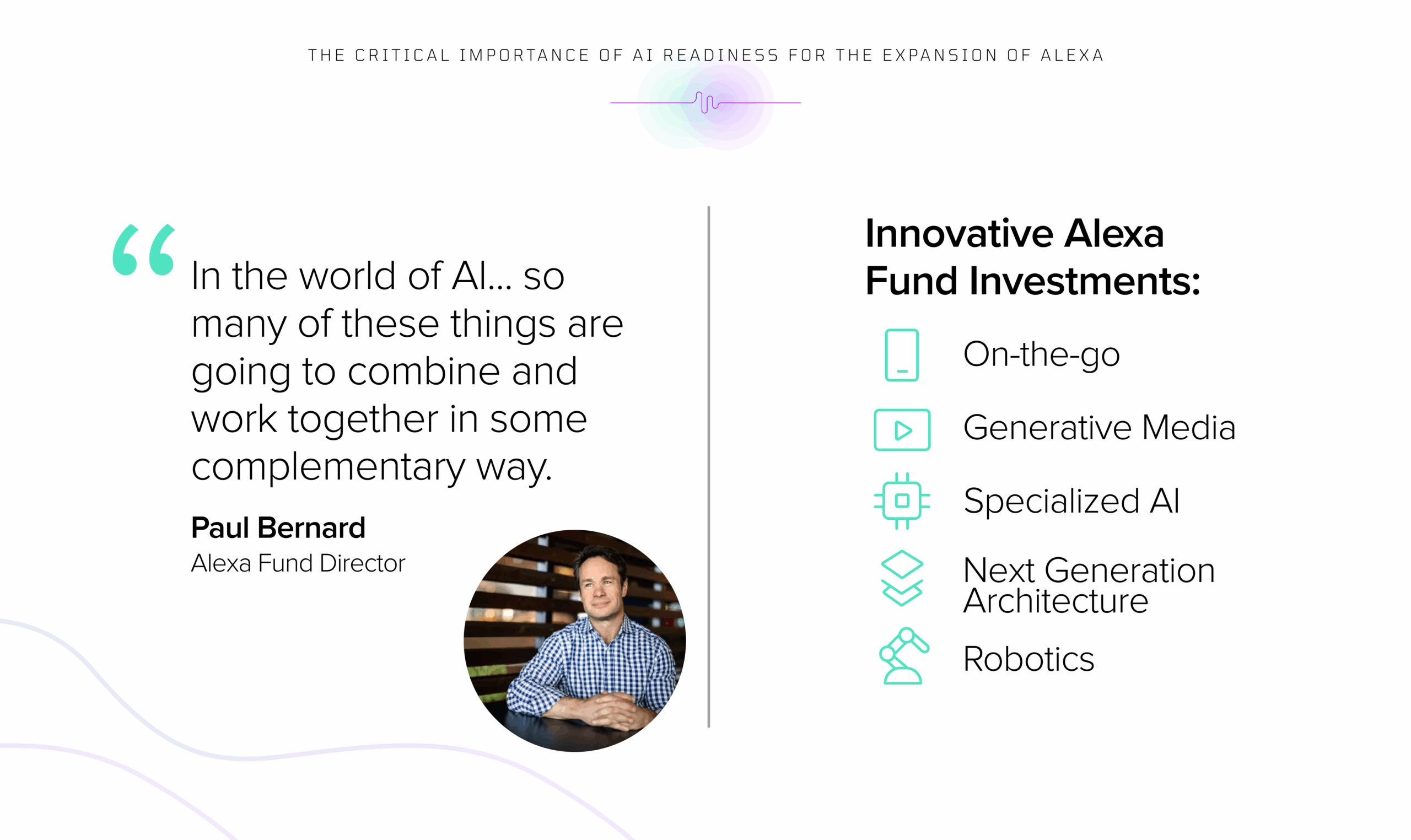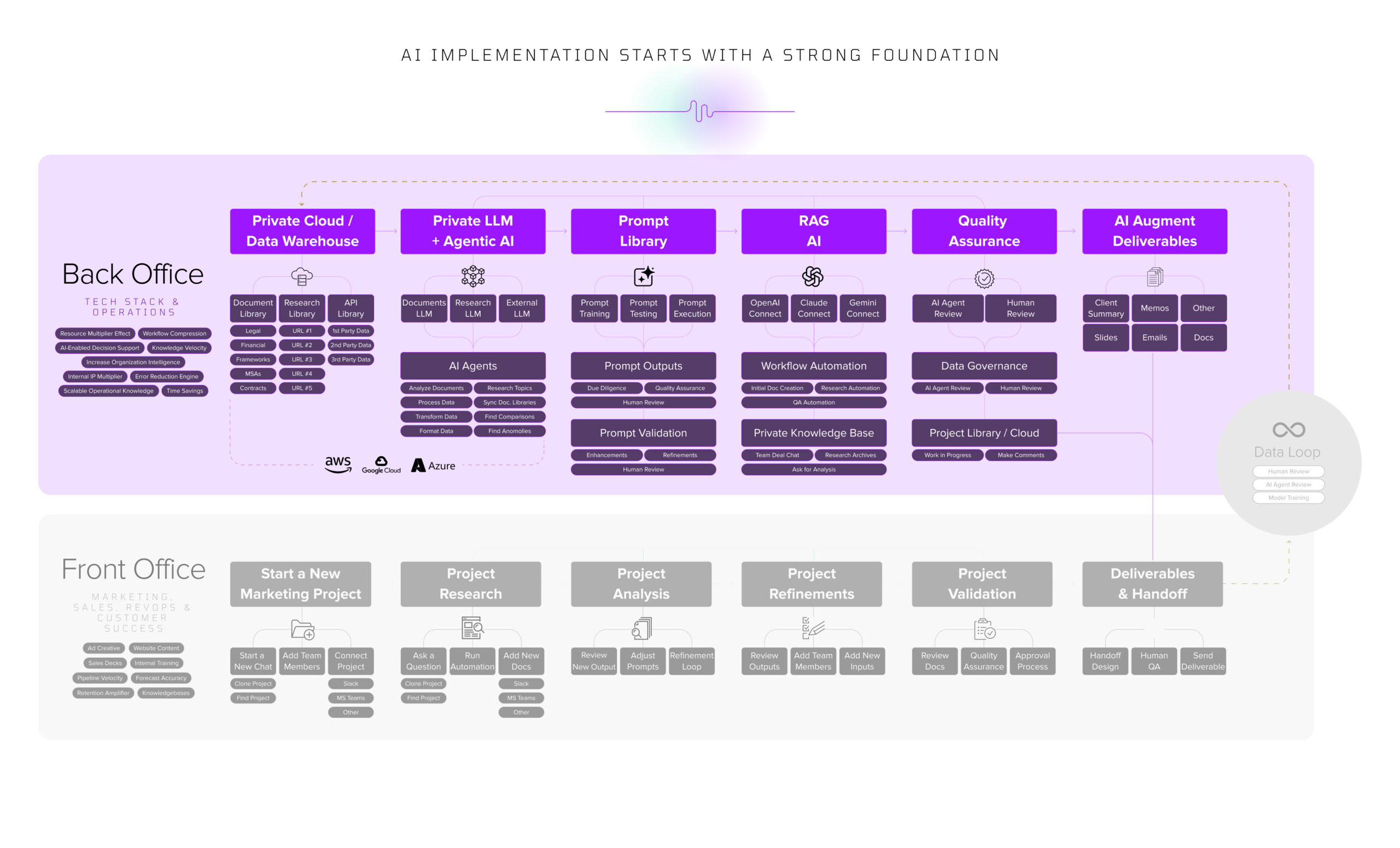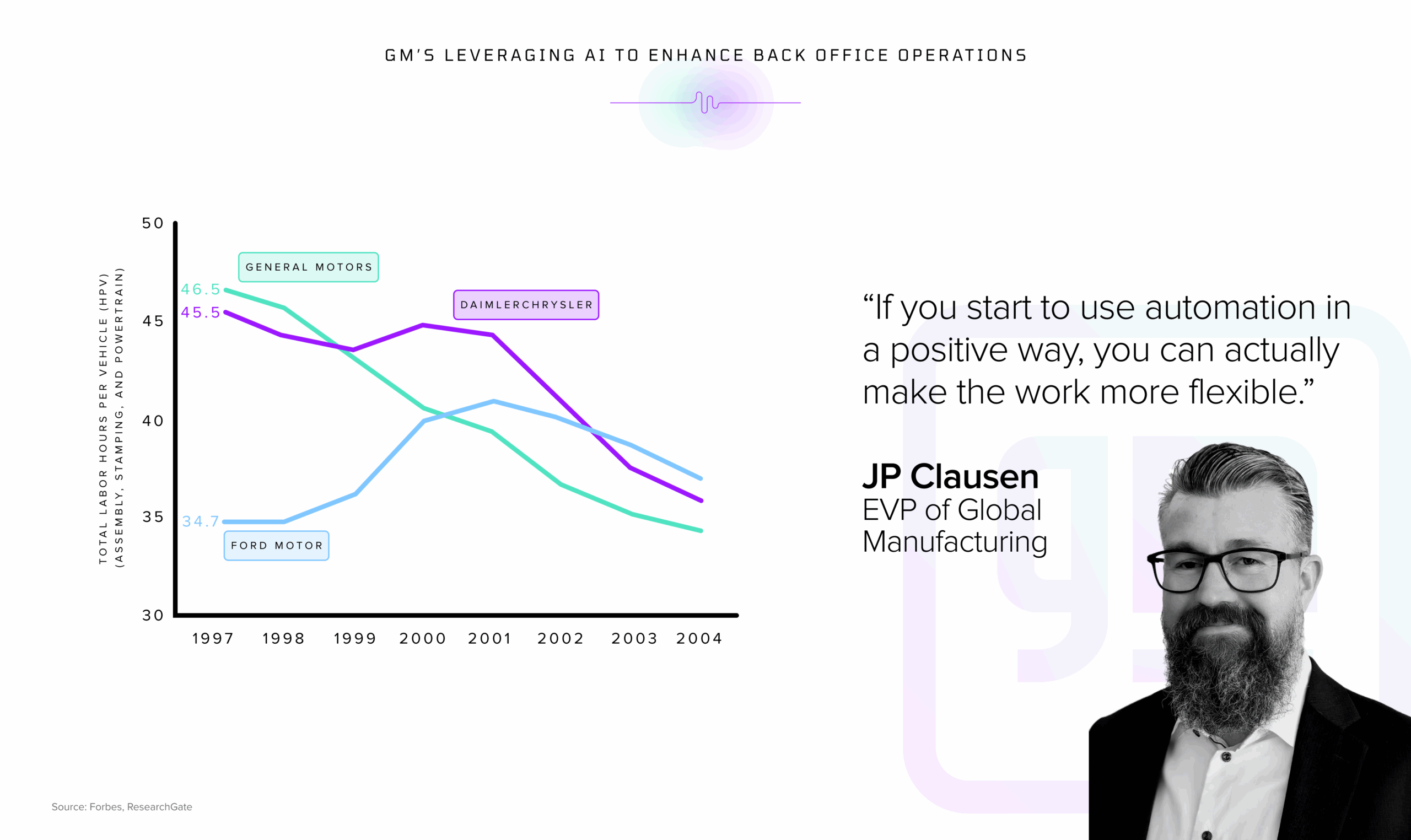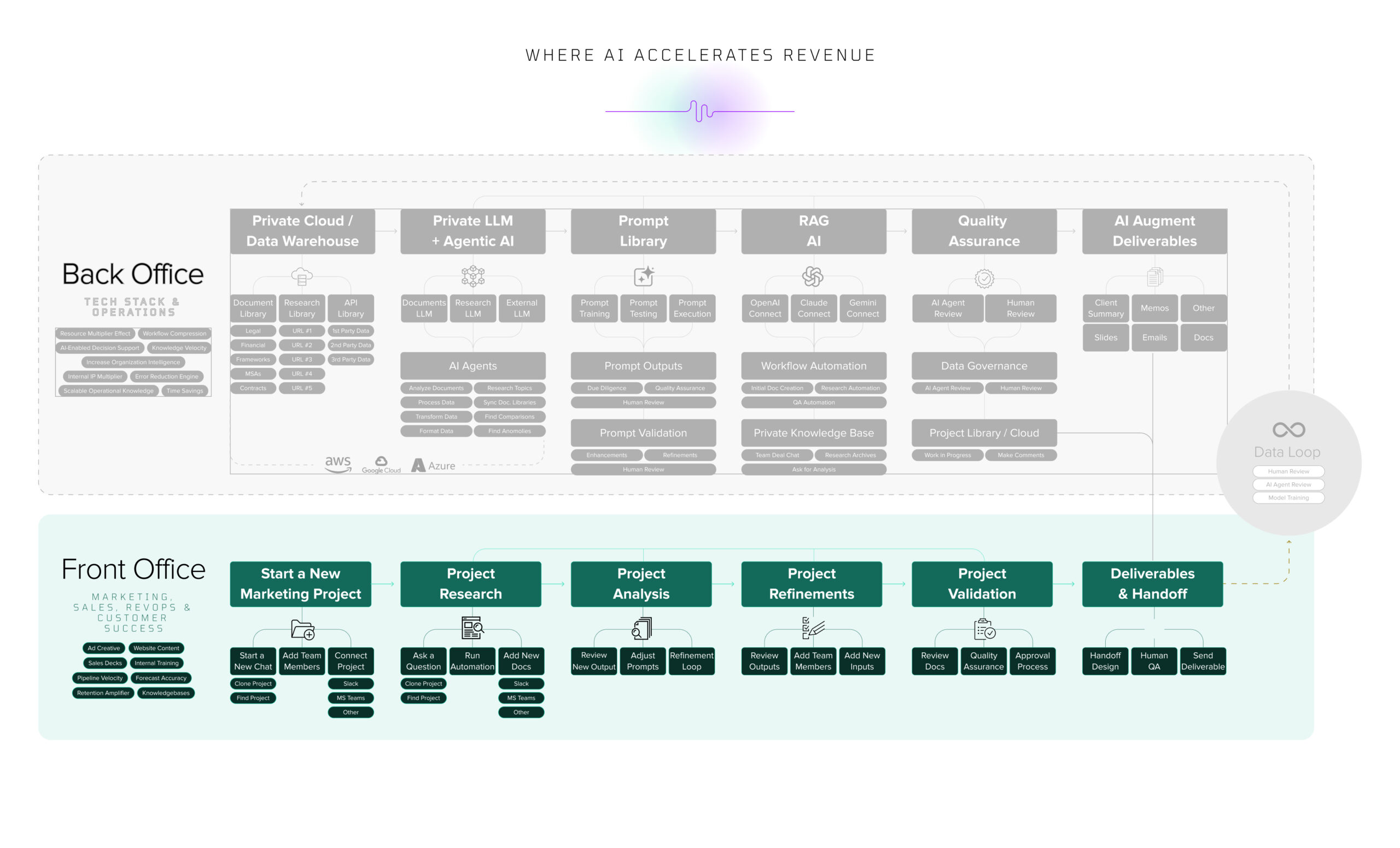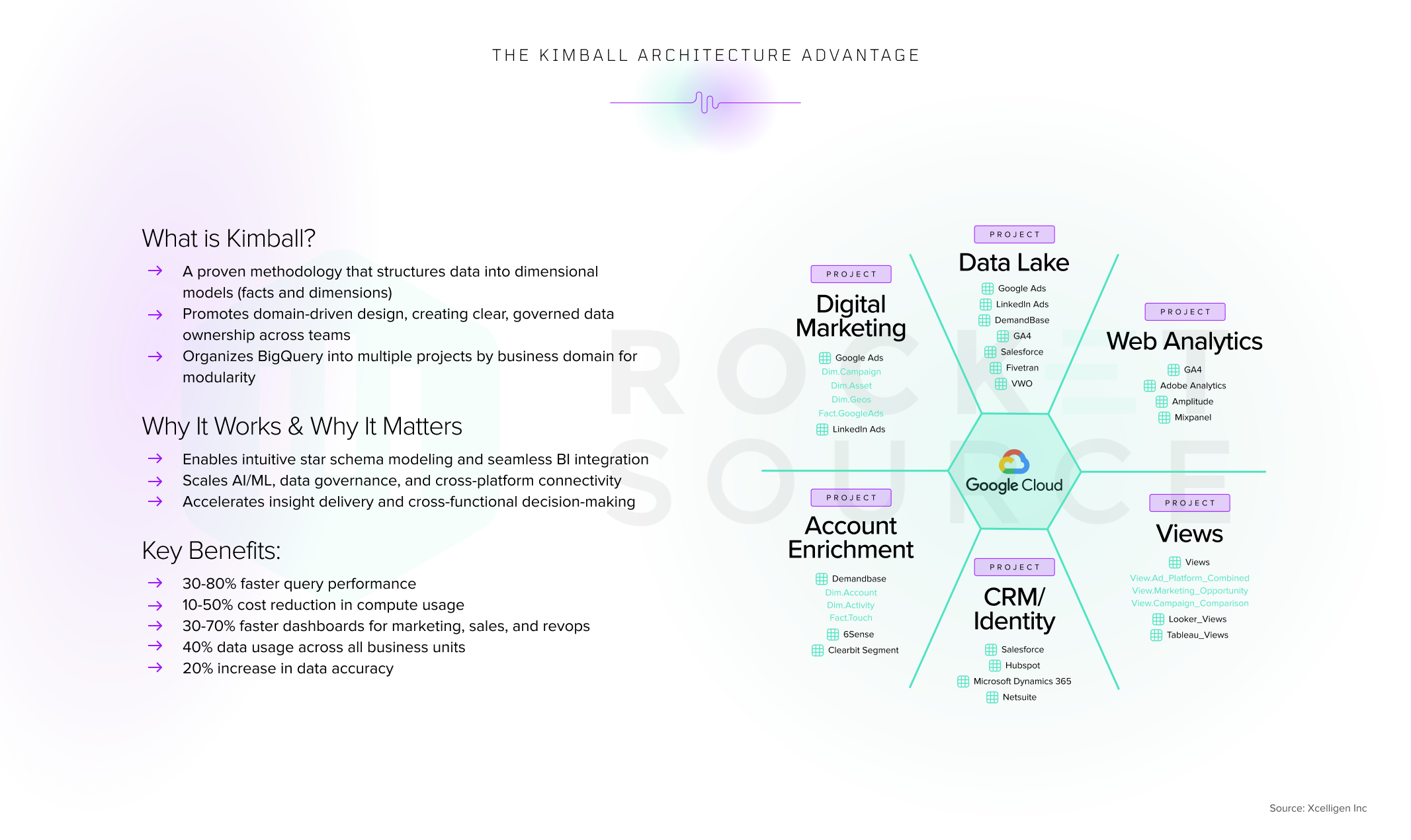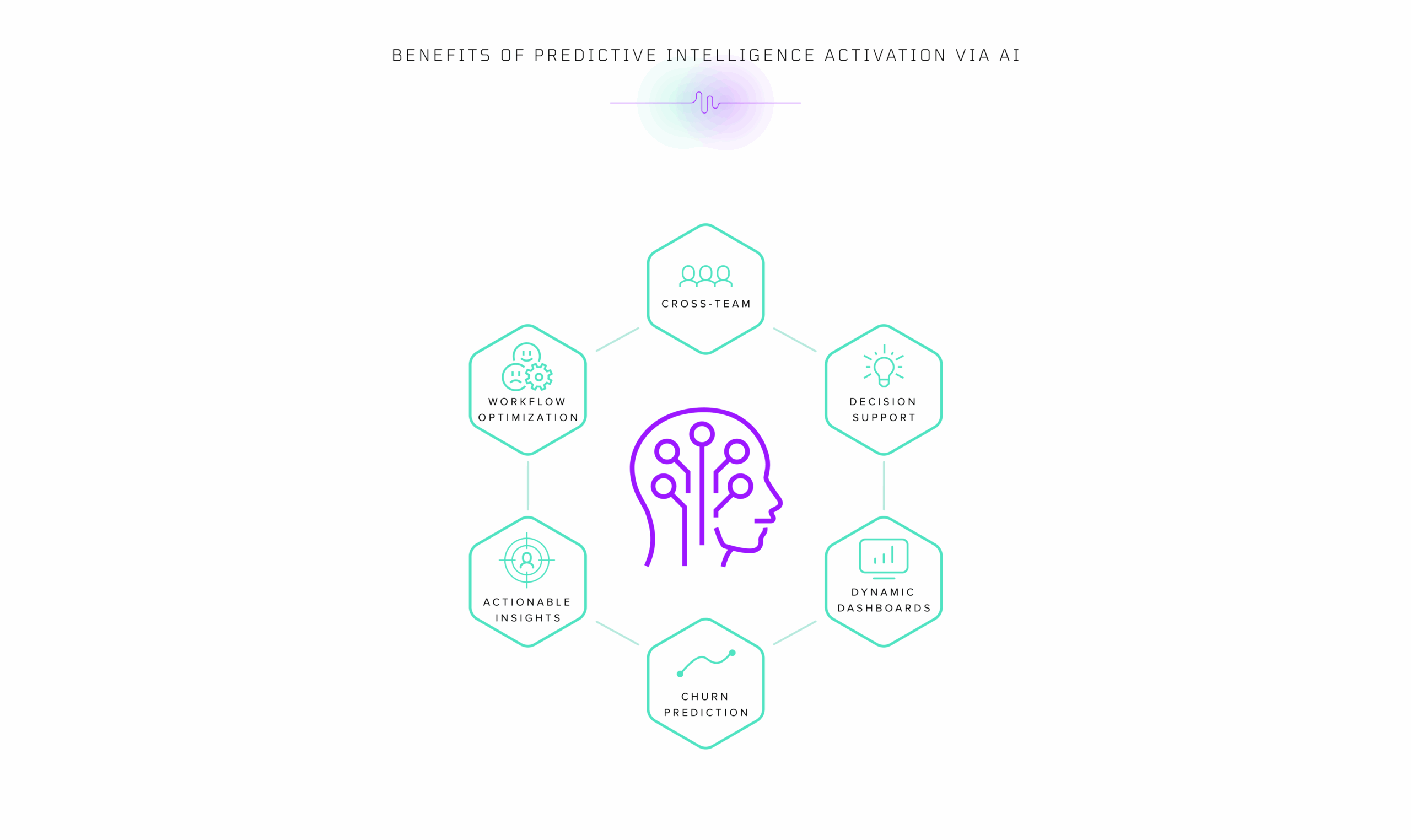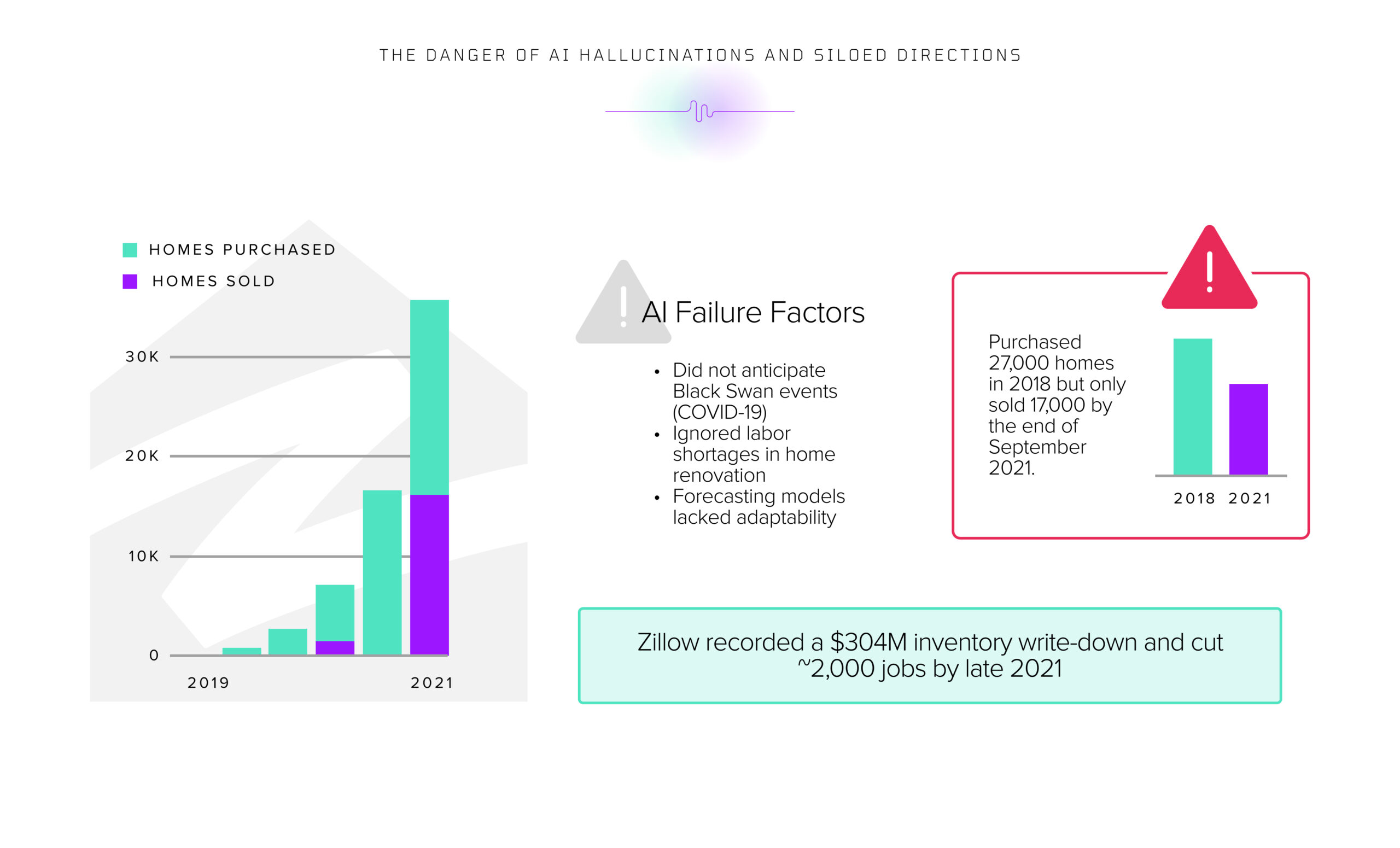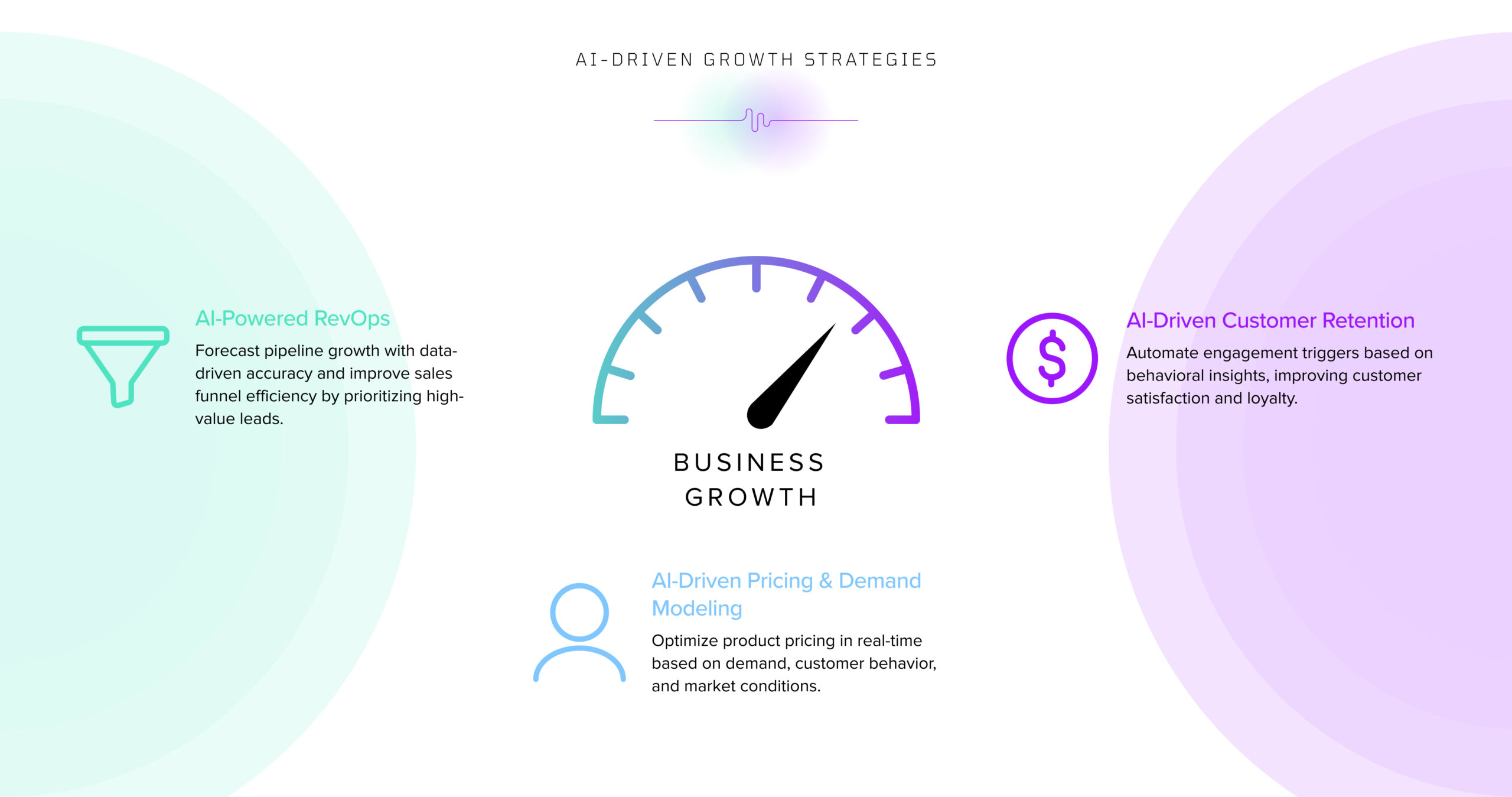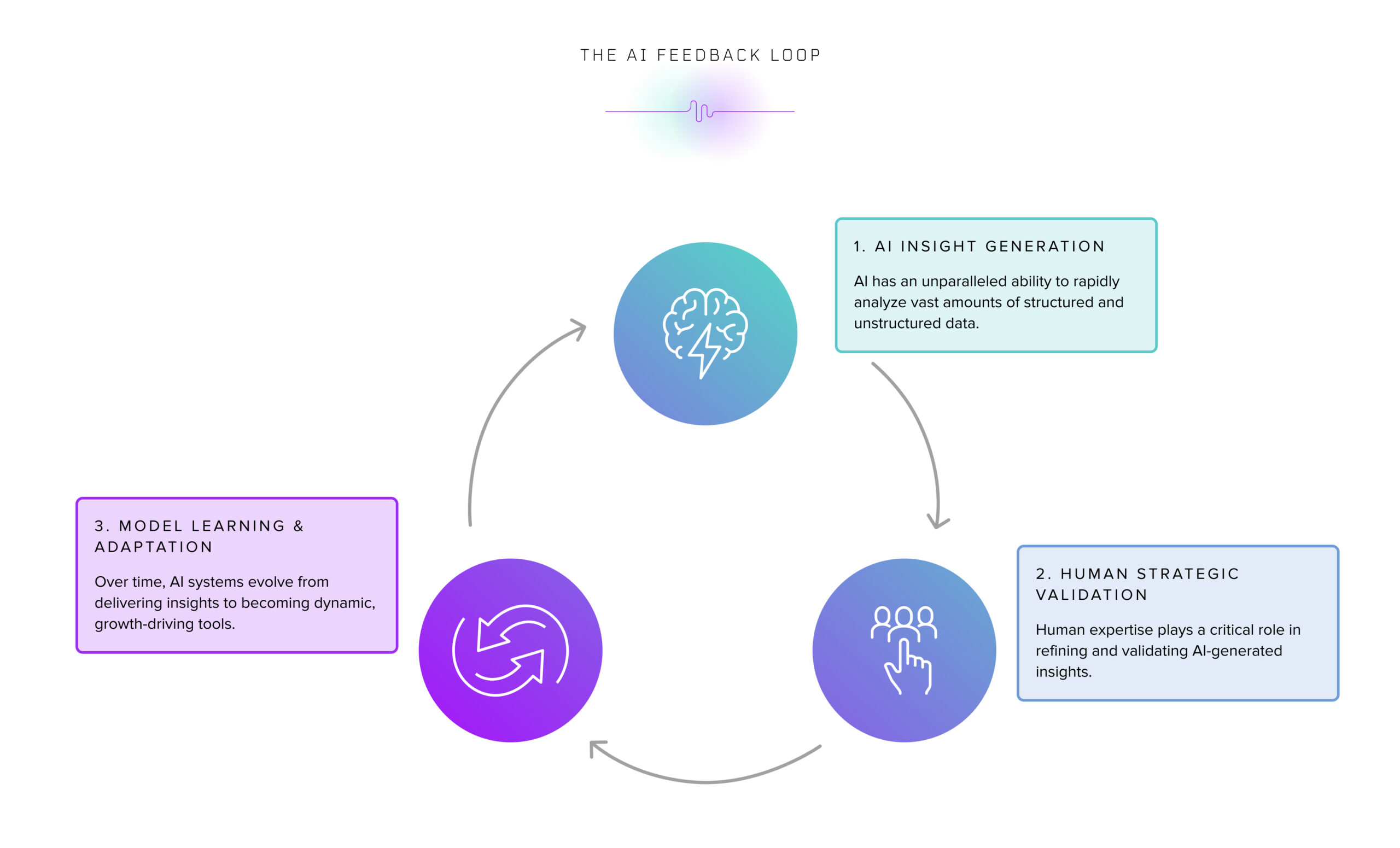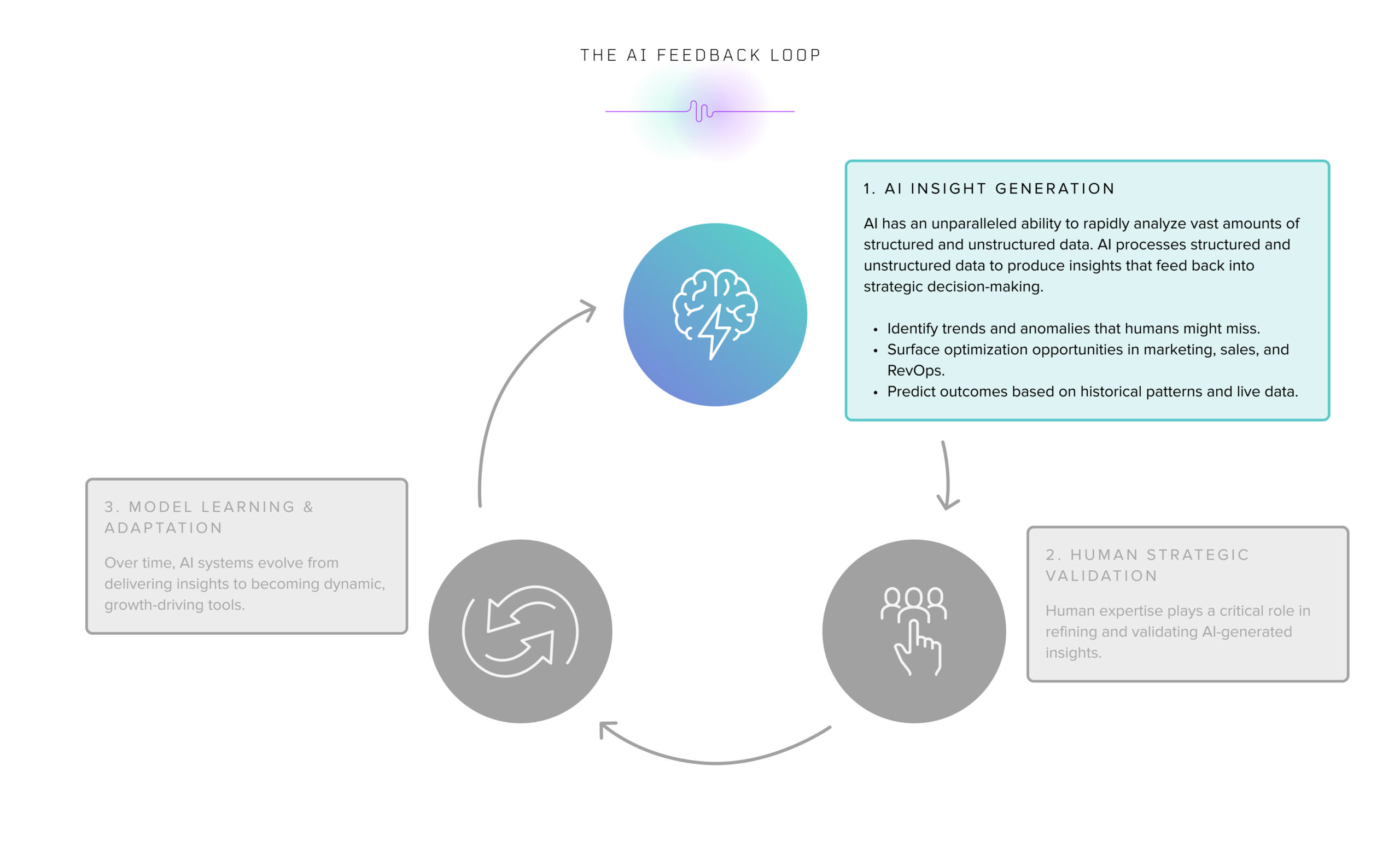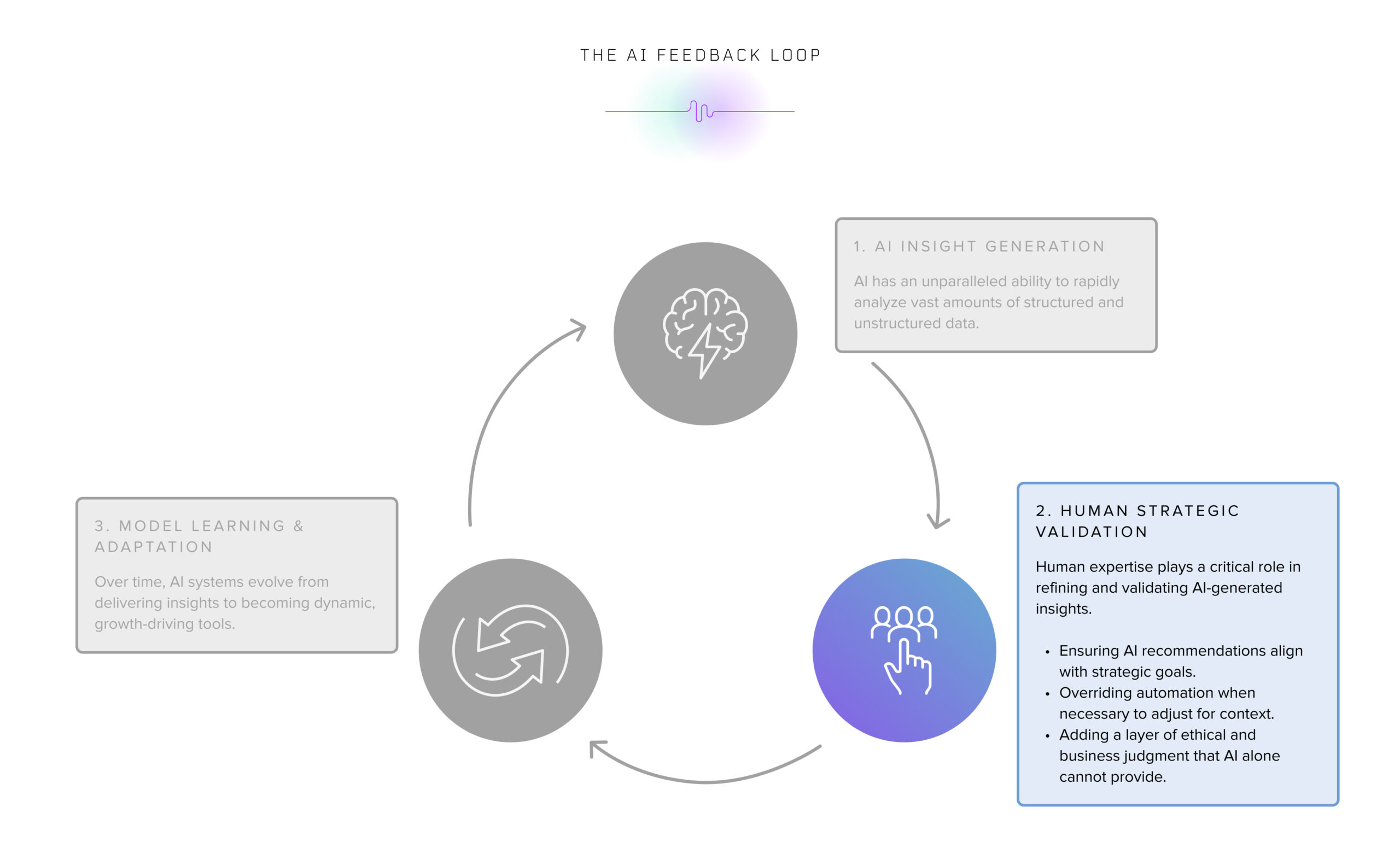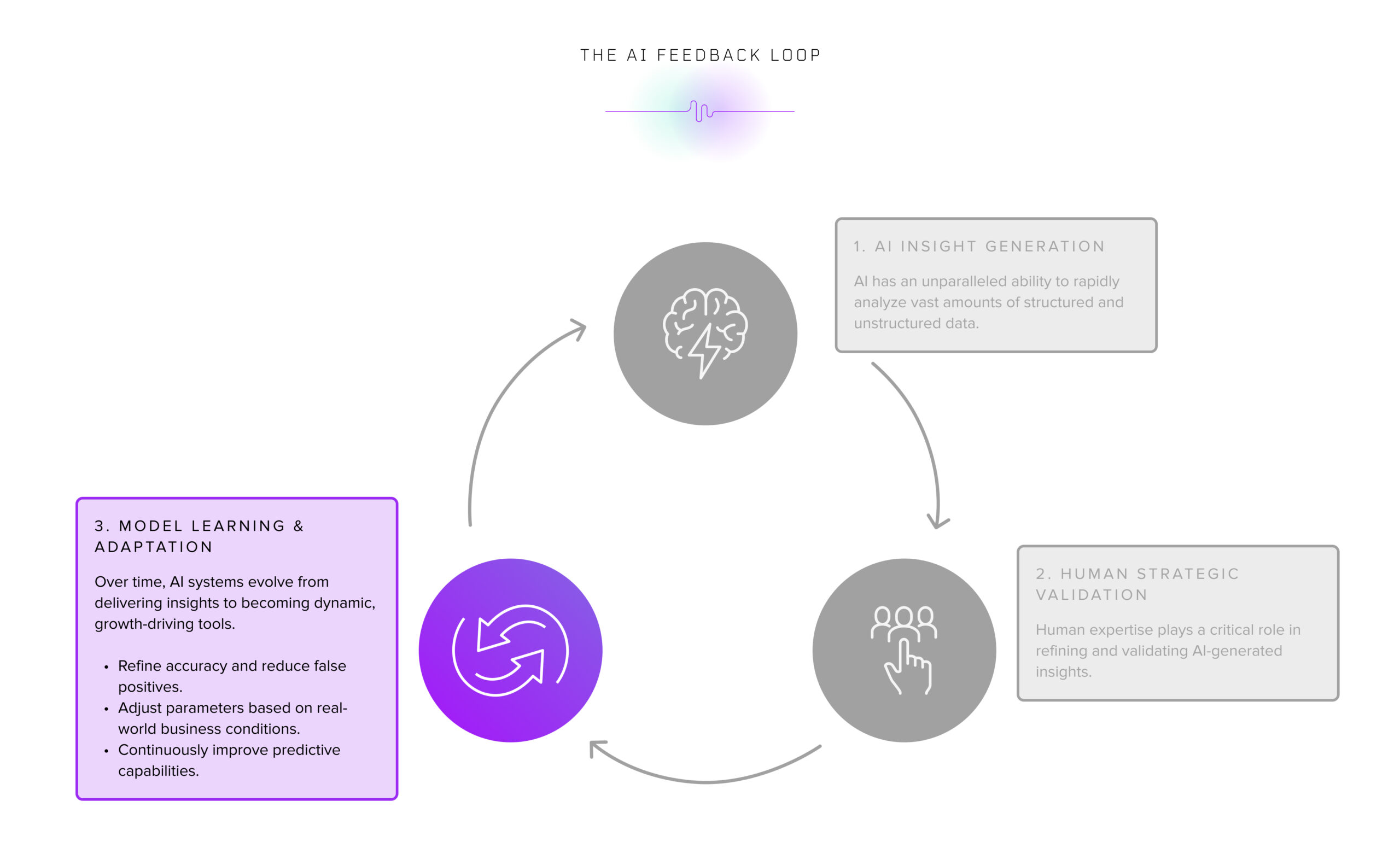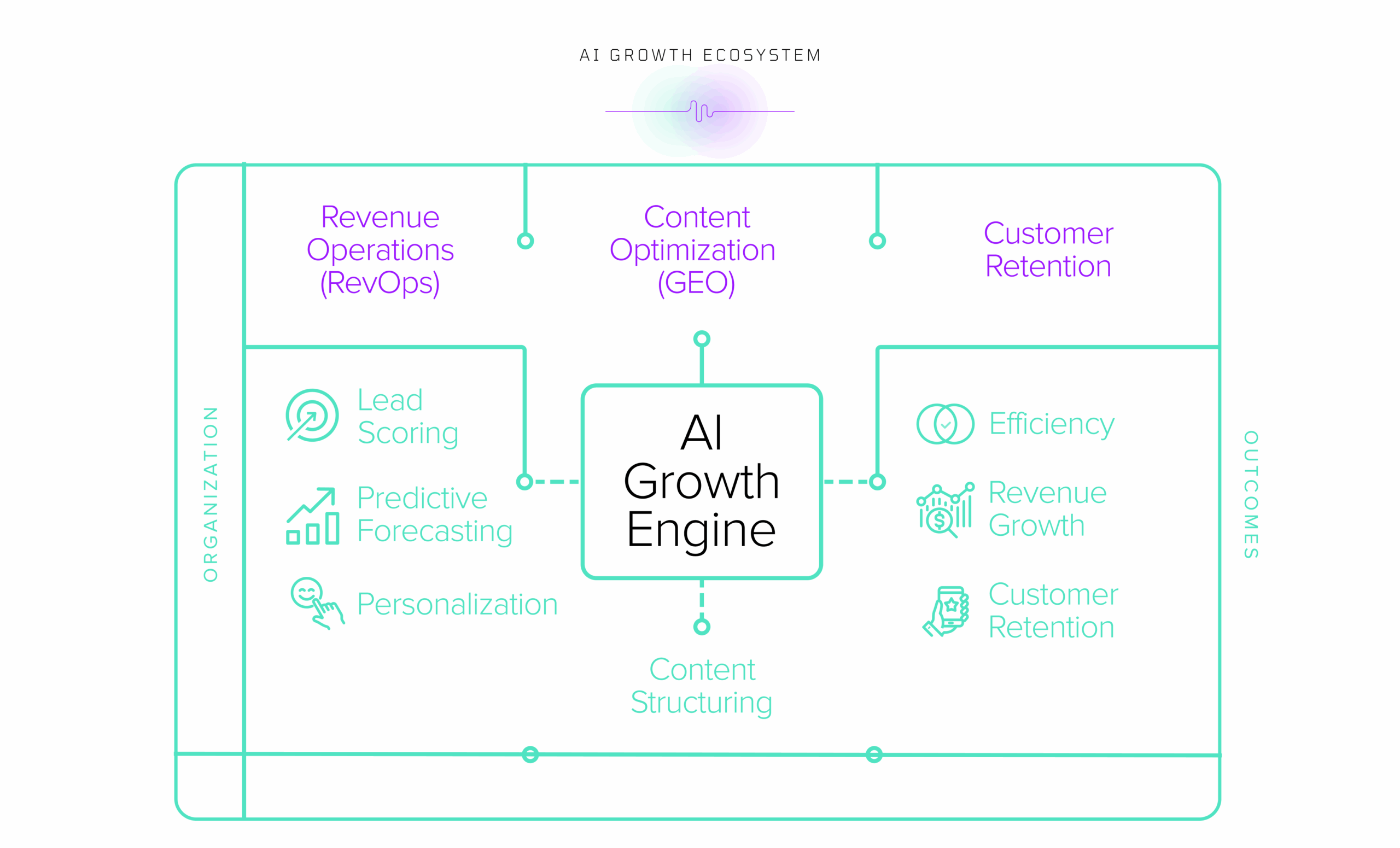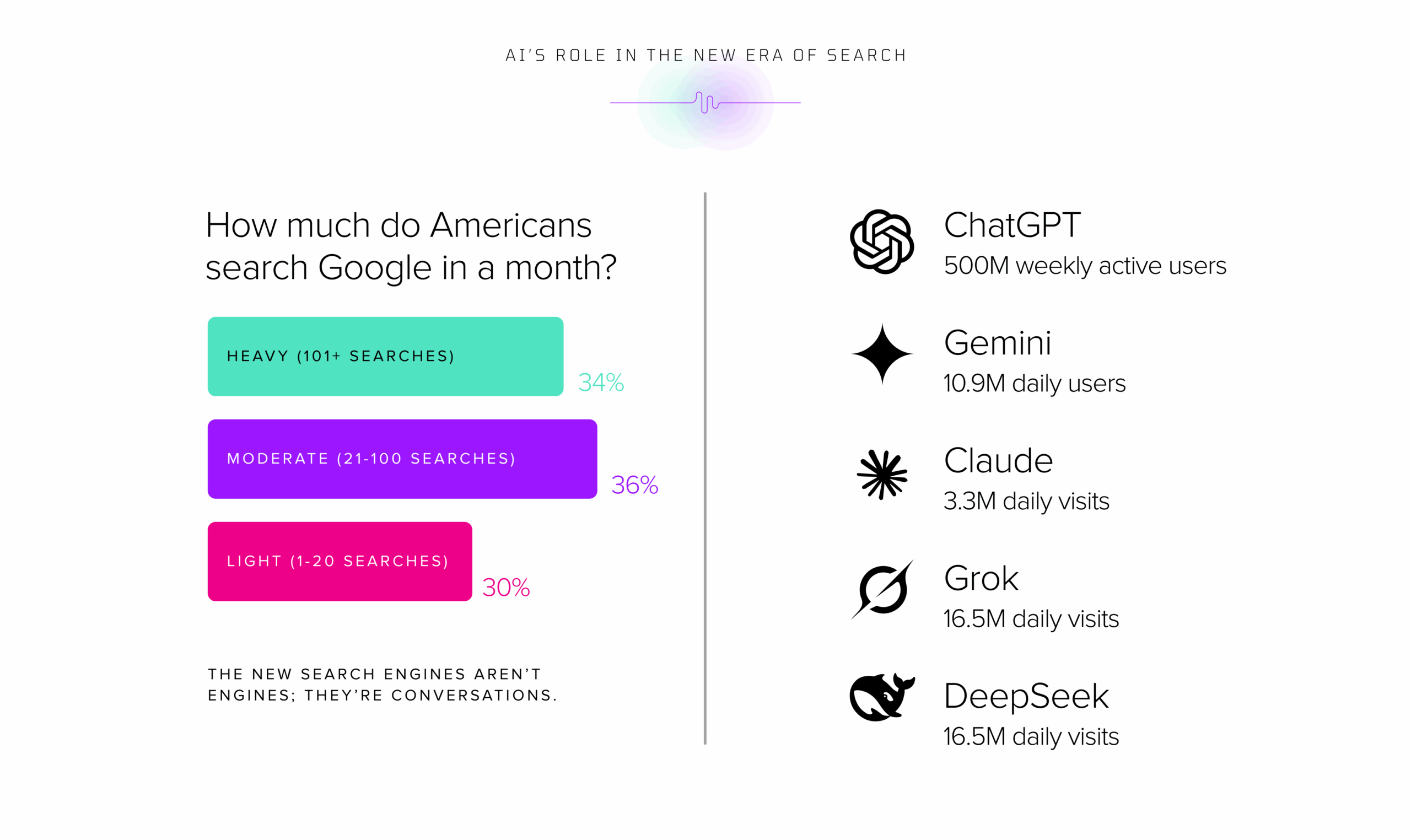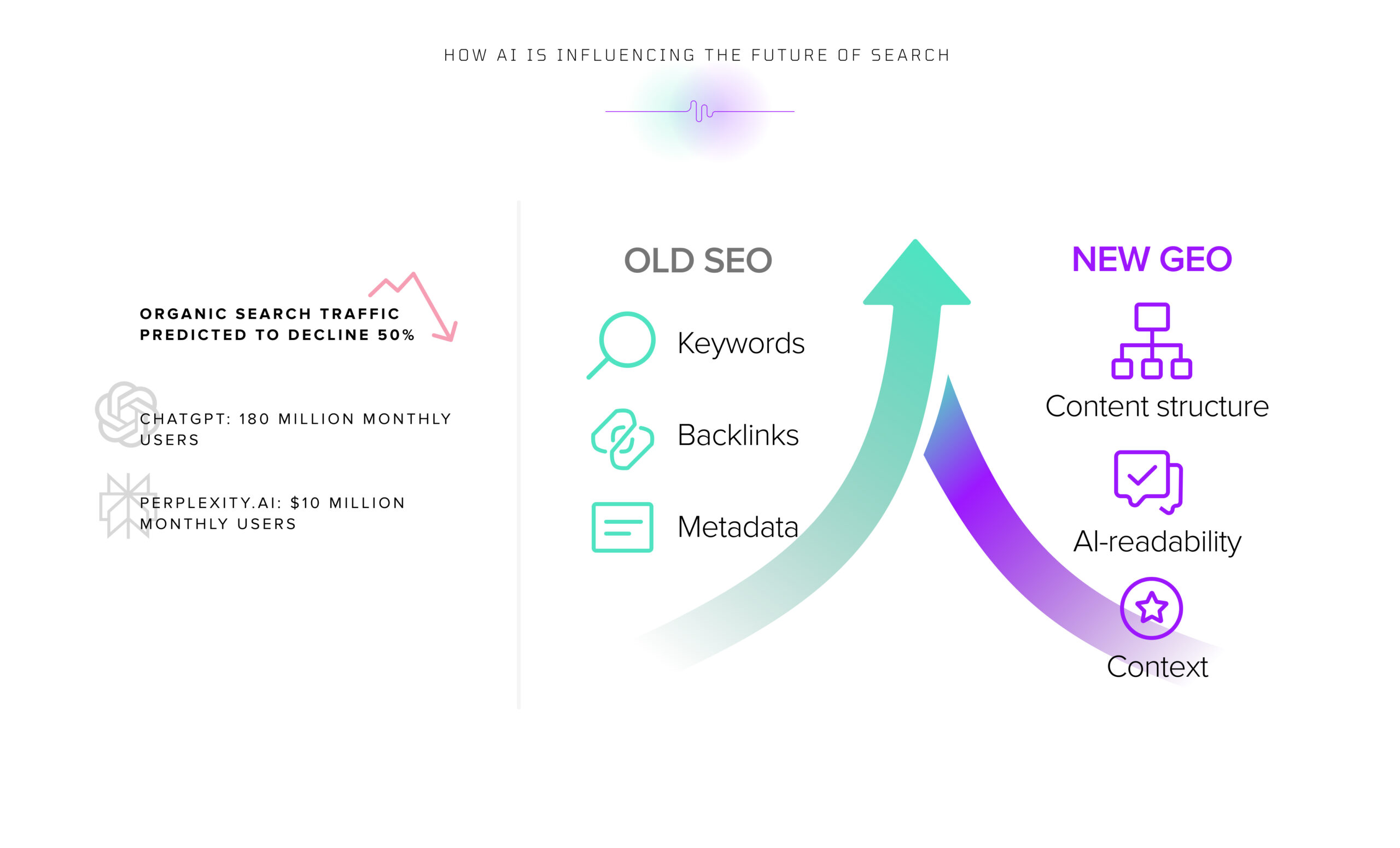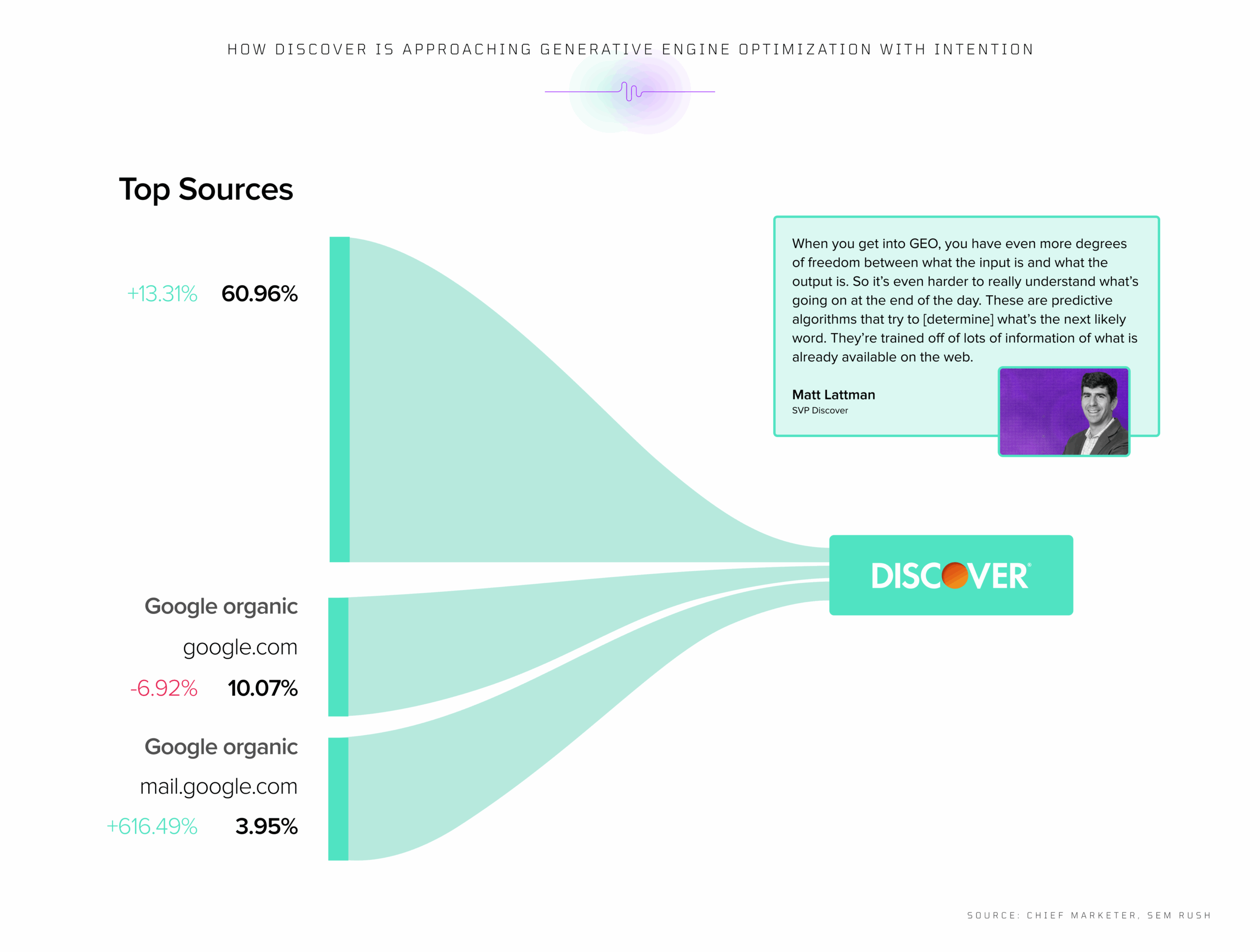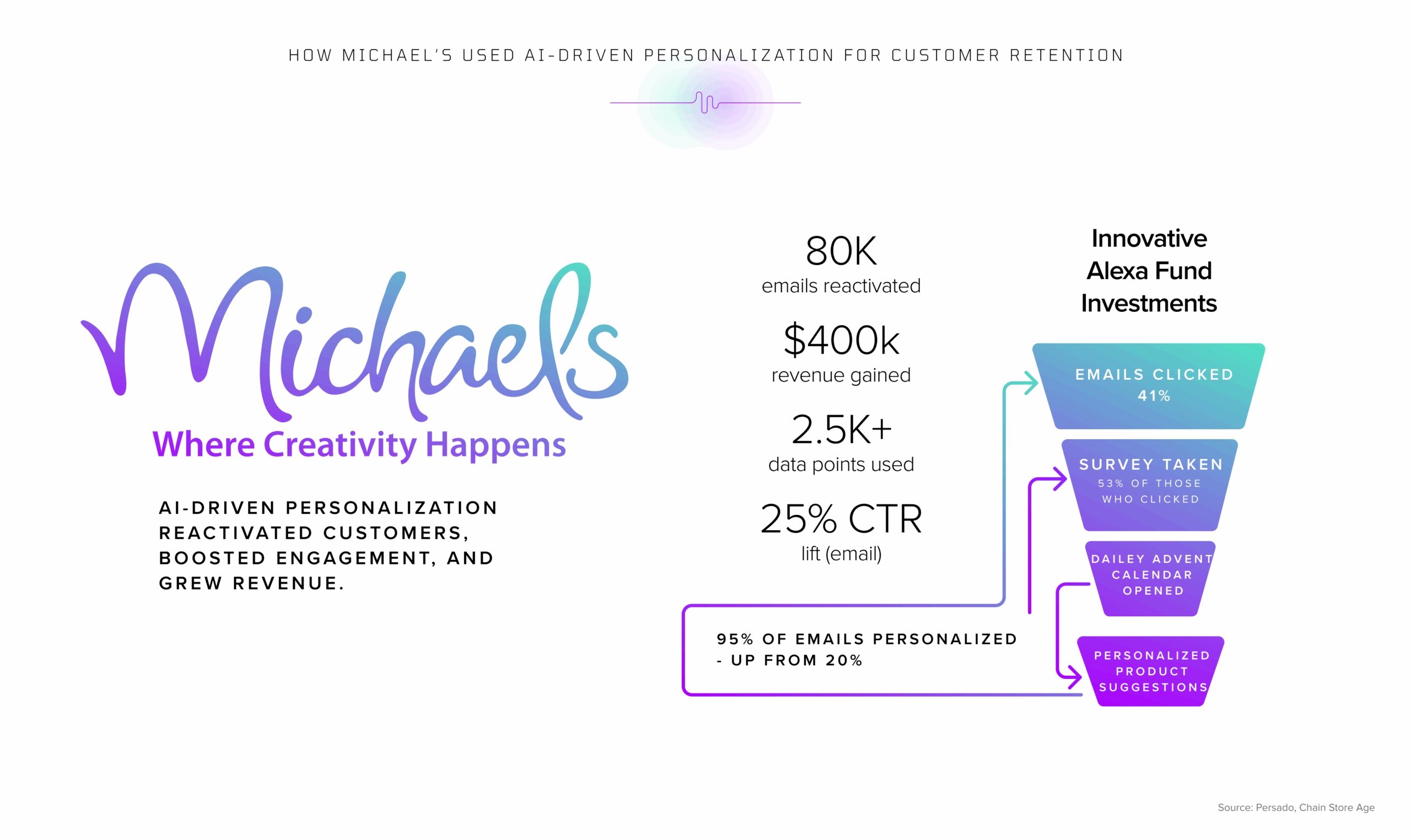Effectively Deploying Artificial Intelligence Strategy at Scale
Stories of another artificial intelligence strategy splatter headlines almost daily. That’s because winning organizations aren’t just experimenting with artificial intelligence (AI) anymore. They’re orchestrating platforms for automation, predictive analytics, and streamlined processes.
While it may seem like everyone has it all figured out, the reality is that many teams still struggle with AI adoption. Instead of streamlining operations, it creates silos. Feel familiar? The problem isn’t the tool. It’s the lack of a structured approach rooted in human behavior and a strong qualitative data practice. Successful AI deployment extends far beyond simply plugging in a new platform and expecting it to run seamlessly in the background.
Effective AI strategy is about doing more with what you already have and turning those capabilities into scalable, sustainable growth.
When structured properly, AI acts as an amplification model. It doesn’t just automate tasks; it scales expertise, enhances operational efficiency, and deepens customer relationships.
The companies that get AI right are the ones that create an integrated AI framework that supports growth across the entire organization, from data structuring and predictive analytics to personalized customer experiences. If you want the same for your organization, we’re here to break down the details for you. But before we get into the how, you need to understand what’s hype and what’s reality, because that line is often blurry when it comes to AI.
The AI Hype vs. Reality
The market is flooded with AI-driven solutions promising the world. You’ll be hard pressed to ignore headlines touting the efficiency, cost savings, hyper-personalization, and promise of AI’s potential these days, and for good reason. In a 2024 survey of C Suite executives, PwC found that most businesses are adopting generative artificial intelligence (GenAI) at scale.
Over half of executives have initiated their adoption of AI, finding that new automations, processes, and platforms have already led to increased employee efficiency (56%). Additionally, more than a third have seen an uptick in revenue (32%) and profitability (34%). Perhaps wins like these are why Amazon’s CEO, Andy Jassy, recently urged companies to invest “aggressively” in AI.
We continue to believe AI is a once-in-a-lifetime reinvention of everything we know, the demand is unlike anything we’ve seen before, and our customers, shareholders, and business will be well-served by our investing aggressively now.
The proof is in the pudding, right? It’s time to invest in AI! While it’s tempting to read statements and stats like the above and jump right in, we caution organizations against moving at the speed of hype.
While each of the outcomes listed above sounds good on the surface, the reality is that the rush to stay relevant can have serious consequences for businesses if not careful. While many organizations have achieved stellar results, leading to increased hype around this technology, there are still numerous hurdles that organizations must overcome to maximize the benefits of GenAI.
If you’re reading the hype headlines and feeling hesitant around AI adoption in your organization, or are worried you’ve already messed this up within your organization, you’re not alone. Many companies are in a state of flux, trying to determine where and how to infuse AI into their current organizational structure.
Looking closer at the PwC survey responses from CEOs, it’s clear that there’s quite a bit of uncertainty around how to infuse AI into the organization as a whole. Technology platforms are closer to the top of the adoption curve, which is clear; however, fewer teams understand the reality of effectively integrating AI into other areas. More specifically, executives are currently trying to determine how to sequence AI effectively so that it has a positive impact on business processes and workflows (41%), workforce and skills (31%), new product or service development (30%), and the core business strategy (24%).
The caution moving forward is wise. In a recent article about user experience design strategy, author Patrick Sharbaugh said:
(The) haste to react to still unproven market hype and satisfy impatient investors and restless creative directors is likely to make the thoughtful adoption of AI in the general population less likely instead of more.
While Sharbaugh’s message is specifically directed at UX strategists, the broader lesson applies to team members across all departments within the organization. The delicate balance between jumping into new technology for outcomes like efficiency, cost savings, and hyper-personalization, and waiting to see how AI fits into the business world most effectively, can cause teams to either crash and burn or fall behind.
Rapid AI Adoption Brings About Major Risks and Challenges
We live in a dopamine world. As crazy as it sounds, we love both pain and pleasure. And it makes sense why. Both come from the same place within our brains. Yet as Americans, we’re especially keen on the pleasure element. The scales have tipped, and now we demand nearly all experiences be pleasure-based. Few are willing to endure pain to get a successful outcome.
Perhaps that’s why the AI hype is hitting the world with such force. We get the pleasure of instant gratification through GenAI response times, but the only minor pain of wondering whether it’s accurate, personal, or precise. We get the pleasure of moving fast enough to keep up with the market and our competitors while avoiding the pain of being left behind. Perhaps that’s why:
The dopamine rush is what drives rapid adoption of AI without methodical, strategic implementation.
No organization can afford to be left behind and risk sliding back on the S Curve of Business. Still, when your organization rushes into AI without a structured roadmap purely out of hype, you’ll almost unquestionably run into a harsh reality of fragmented AI adoption, siloed automation, and lack of a clear strategy.
Fragmented AI adoption occurs when one of your teams adopts AI independently. This rogue approach causes the AI tools used by one department to differ significantly from those used by the next, so that the outputs each team receives can send them down two different trajectories. This happens because large language models (LLMs) are trained on disparate datasets. Without having access to the whole picture, teams often make decisions through a microscope instead of a telescope, focusing on only small parts of a much larger picture.
Rushed AI adoption also leads to siloed automation. These silos pop up where AI automations are put into place in smaller, isolated use cases rather than integrated across all departments as a whole. When this happens, teams start operating with their heads down and without a clear strategy.
While AI might make teams more efficient in the immediate future, and automations might be put in place to take over a tedious work task, the organization will quickly suffer because teams aren’t working together to move collectively to the North Star Metric.
That North Star Metric is the guiding light for the organization as a whole. By not having a clear system in place, AI will struggle to deliver the promised value because it lacks the structure and orchestration that’ll sync all of the ships in your fleet toward that destination. Instead of creating efficiency, AI will ultimately result in disconnected systems, fragmented workflows, and automation that fails to yield predictive insights. Let’s look closer at the risks associated with each natural consequence of rapid AI adoption without a strategic approach.
Challenge 1: Disconnected AI Systems
What do General Motors, Mastercard, and ZocDoc all have in common? Each of these organizations recently appointed a new role in their C-Suite — Chief AI Officer. That appointment likely stems from the number one reason AI underperforms in organizational environments: isolated adoption.
When AI is rapidly adopted by a team, a tool, or a function, it often lacks integration with the rest of the organization. Rather than creating synergy, AI often becomes yet another silo. Different departments deploy AI tools independently, without coordination or shared context. For example:
- The marketing team runs AI-powered ad targeting
- The sales team uses an AI-driven lead scoring model
- The RevOps team relies on AI analytics for forecasting
- The customer success team deploys chatbots to handle inquiries
The list continues across each department in your organization. Each system may work well on its own, but when they are not connected, critical insights fall through the cracks, and customer experiences feel fragmented. The result is a patchwork of smart tools with no orchestration, leaving teams misaligned and missing out on the full potential of AI.
The result of this lack of alignment isn’t just an internal inefficiency eroding the employee’s experience, but also a frustrating experience for the customer. Instead of a cohesive journey, customers may feel like they’re interacting with different, disjointed departments that don’t share information, which reduces trust and diminishes the overall brand experience. Internally, this fragmentation results in missed opportunities, lower productivity, and wasted resources as teams fail to leverage insights from each other’s AI tools.
One instance where we’ve seen organizations consistently miss the mark is with customer data platforms (CDPs). CDPs are designed to be a centralized hub for all customer data, so it makes sense that when teams identify AI capabilities, they integrate the tools that come with the software and expect it to run seamlessly. More specifically, they expect these tools to facilitate effective front-facing conversations with customers. However, the prolific approach to AI chatbots in today’s market is eroding customer experiences quickly.
Half of customers prefer interacting with a real person, and only 12% prefer working with an AI chatbot to resolve their concerns. And it makes sense. Between a GM Dealer’s chatbot selling a 2024 Chevy Tahoe for $1, AirCanada’s chatbot giving a grieving customer incorrect information about bereavement discounts, and Bing’s chatbot consistently having issues, chatbots are getting a reputation for being less than reliable.
Our team has also encountered issues and concerns with chatbots. On a recent work trip, one team member’s truck had a concerning issue. Rather than being able to call the dealer and ask if they should bring it in or if the issue wasn’t urgent, they were sent through a chatbot to diagnose the concern, leaving them with more questions than answers.
Chances are, you’ve heard similar stories in your circles. That’s because these experiences aren’t uncommon, as disconnected AI systems continuously lead to inaccurate information coming from the back office, eroding the experiences for both customers and employees in the front office. Yet there are 500 million active weekly users on ChatGPT, 76 million weekly visits to Gemini, and 23 million weekly visits to Anthropic’s Claude.
Consumers and the workforce are turning to chatbots for answers, yet they’re unhappy with the responses they get.
When we, as consumers, want knowledge and understanding, we’re okay with AI. However, when we need something simple, such as car repair, we become frustrated and prefer not to use it. What gives? More on how to remedy this disconnect will be discussed later in the post. For now, let’s look closer at the silos that naturally evolve out of disconnected AI systems because to fix this issue, we need to understand what the problem looks like in closer detail.
Challenge 2: Siloed Automation Attempts
Siloed automation attempts are another common challenge stemming from disconnected systems. When organizations adopt AI in small, isolated pockets without integrating it into broader business functions, they do so without established guardrails in place. That lack of guardrails can cause teams to go rogue, feeding the system different information through various contexts without categorizing or organizing what the models should learn. When this is done, it increases the potential for AI to hallucinate, generating unique answers for each team that do not consider the broader picture. Those hallucinations often send each team going in dramatically different directions.
AI hallucinations occur when false, incorrect, or nonsensical information is presented as the output, rather than accurate information. This happens more frequently than you might realize.
Insufficient quality data being fed to the large language model (LLM), faulty architecture resulting in simplified results, overfitting leading to irrelevant outcomes, or improper generation methods can all lead to outputs that fall short. The challenge for organizations is that these outputs are often trusted heavily by team members. Rather than thinking critically and strategically through each output or monitoring the outputs, people come to trust AI fully. And, when a hallucination does occur, it often goes unnoticed because of this lack of oversight, causing the team to move in a very different direction than their counterparts down the hall. Worse yet, hallucinations can erode customer trust when shared publicly.
To illustrate how AI hallucinations can tarnish a brand due to a lack of human oversight, consider the classic case of a Microsoft travel article that sent readers in the wrong direction. The site relied on AI to research and write its articles, only to have AI hallucinate and recommend a local food bank as a hotspot to visit in Ottawa. The article has since been taken down, but Imgur has a picture of the article, which included the Ottawa Food Bank as #3 on their list of recommended destination hotspots.
Human oversight will quickly tell you that the Ottawa food bank isn’t a tourist destination. Nor should tourists arrive on an empty stomach when they’re visiting the area. This error occurred after 50 reporters were laid off due to an increase in the use of AI in Microsoft’s articles. When the article’s hallucination came to light, the public’s trust in Microsoft News and the brand as a whole weakened.
When AI tools are not integrated across departments and are not consistently calibrated to point the organization toward its North Star Metric, their insights are not being applied strategically. This siloed approach to AI implementation often stems from a focus on immediate results. AI is often viewed as a solution to isolated problems, such as predicting churn, improving recommendations, or streamlining a specific process, rather than as part of a larger strategic vision. As a result, many companies invest in sophisticated AI tools but fail to realize their full potential because they aren’t thinking holistically about how AI can impact the entire business.
Challenge 3: Lack of Predictive Decision-Making
Taking a predictive stance is paramount for businesses to stay moving up the S Curve of Growth. Yet a common pitfall in AI adoption is that organizations often use it primarily for historical reporting rather than for predictive decision-making. While there is value in understanding past trends, the real power of AI lies in its ability to predict future outcomes and drive proactive strategies based on past behaviors, especially in the retail industry, where organizations spend money to attract foot traffic.
One area that is making significant strides in overcoming this lack of predictive decision-making is the climate-related industry, which is now analyzing federal climate data to help mitigate hazard risks from major climate events.
Following recent climate crisis events, such as Hurricane Helene in North Carolina and the ongoing wildfires in Southern California, it has become increasingly clear that there is an urgent need for disaster preparedness. To help, a comprehensive climate simulation dataset called ClimRR was publicly released in 2022 through a partnership between FEMA, Argonne National Laboratory, and AT&T. Over the past two years, these organizations, along with Project IN-CORE, have collaborated with state and local governments to utilize ClimRR data for enhancing emergency management and mitigation plans, leading to greater awareness of climate-related disaster risks.
Two entities — Kentucky’s Barren River Area Development District (BRADD) and Albany County, New York — have already leveraged ClimRR data and free consulting to update their hazard mitigation plans and make more informed decisions regarding disaster preparedness. Officials in both regions emphasize that the data helps them proactively prepare for increasingly frequent extreme weather events, even if convincing residents to invest in preparedness can be challenging. The public availability of ClimRR aims to predict disasters more effectively before they strike, enabling entities to develop widespread resilience.
This shift from reactive to proactive is where AI’s true value emerges, not only in the climate industry but also in the business world. While these challenges may seem daunting, the reality is that with proper AI sequencing, teams can implement systems and strategies that more effectively and efficiently meet the needs of customers and employees, resulting in a better brand experience. But, for that to happen, organizations must adopt the correct AI sequence so that all the dominos fall into the right pattern at just the right time.
AI Requires Human + Machine Synergy
Many businesses fall into the trap of viewing artificial intelligence as a one-time solution—a sophisticated tool designed to automate tasks, generate insights, and streamline operations. But, much like human beings, AI is a living, evolving ecosystem that requires consistent oversight and optimization to remain effective. Perhaps no one has painted a clearer picture of why human and machine synergy is more critical than Mo Gawdat, the former Chief Business Officer of Google.
In this video, Mo outlines how AI continuously learns. His voice has fascinated us as a team for a while, which is why we shared another interview with him in one of our past posts on generative artificial intelligence. In particular, we like his perspective on how we approach AI systems. That approach will determine how the systems approach us.
For businesses, that same concept holds. The data, structure, learning environment, and consistent teachings determine how well AI can be used alongside the organization’s goals without becoming misguided, inaccurate, and dangerously misaligned.
The very technology designed to accelerate growth can inadvertently steer an organization off course when left unmonitored and unrefined. Therefore, harnessing AI’s full potential requires businesses to implement a structured AI Feedback Loop, much like a parent gives to a child. This continuous learning framework ensures that AI systems do more than merely regurgitate insights. Instead, they actively learn, adapt, and improve over time through deliberate human oversight.
By establishing a feedback loop where AI-generated insights are consistently refined and contextualized through human expertise, organizations can ensure their AI systems remain agile and aligned with real-world complexities.
The Balance Between Automation and Human Oversight
Possibly one of the most high-stakes applications of AI in today’s world is autonomous driving. These vehicles rely on AI to know when to stop, when to go, when to turn, and when to avoid an accident. While extensive testing has been conducted on these vehicles, much of it has occurred in simulated environments. That’s concerning, according to the CEO of Waabi, an AV trucking company, Raquel Urtasun:
If you’re testing something that is not realistic, even if you solve all the cases, who cares, if it’s not correlated with reality?
Often, organizations across various industries approach AI through simulated environments. What seems like a strong use case on paper doesn’t always take into account the real-world experience. That’s why AI cannot replace human decision-making, nor was it ever intended to. Its fundamental purpose is to enhance and elevate human decision-making and abilities, making everyone more efficient. That elevation becomes challenging without the proper framework, sequence, or human oversight.
Businesses that assume AI systems can function without ongoing human oversight often find themselves grappling with costly, avoidable issues.
Without oversight, teams place an over-reliance on AI automation. They also lack adaptability to the organization’s shifting directions and strategies, resulting in significant friction in their overall experience. And when AI is left to its own devices, working off old patterns, AI-generated biases and inaccuracies can lead organizations down the path of obsolescence by failing to recognize and adapt to new consumer preferences or emerging trends.
Still, research from McKinsey & Company on the current state of AI shows that the majority of generative AI outputs are not reviewed before usage. Although some organizations have begun to mitigate AI risks, such as inaccuracy, intellectual property infringement, and privacy concerns, there remains a significant need for human oversight to ensure that AI systems do not deviate from their intended purpose.
The most powerful AI systems are those designed to learn, adapt, and grow through a collaborative partnership between human insight and machine intelligence.
To unlock data humanization and AI’s true value, organizations must implement a feedback loop that combines human expertise and machine intelligence to refine decision-making. Human oversight plays a critical role in evaluating AI-generated insights, identifying areas where biases may have emerged, and recalibrating models to enhance their accuracy and relevance. This collaborative approach ensures that AI systems remain dynamic, responsive, and aligned with the company’s evolving objectives.
Over-Reliance on Automation
Shopify recently announced that it is freezing all new hires unless there is adequate proof that AI cannot perform the job. In a publicly shared memo, Shopify CEO Tobi Lutke said:
“What would this area look like if autonomous AI agents were already part of the team? This question can lead to really fun discussions and projects.”
The goal of this strategy is to multiply efforts by Shopify’s current workforce, which is a sound approach. However, some worry that it could lead to an overreliance on automation and AI.
AI significantly boosts efficiency by enabling rapid insight generation. Still, if businesses lean too heavily on automation, removing humans from the equation, it can inadvertently produce decisions that are misaligned with broader strategic objectives. Without the safeguard of human oversight, organizations like Shopify risk basing decisions on incomplete or outdated data, which can cause entire initiatives to go off course. This lack of refinement doesn’t just impact business outcomes; it directly affects both customer and employee experiences.
Every decision made about where and how to establish AI must revolve around the organization’s why.
To illustrate the importance, let’s examine how AI influences both concentric circles.
In this graphic, you can see two areas along the customer’s journey. In our Customer Insights Map, we have identified two distinct areas where AI has been applied correctly and incorrectly.
In the first section, AI was left unmonitored by team members, who trusted it to perform its job without their intervention. Without monitoring the chatbot responses or AI automations that met the customers along their journey, trust faltered. That lack of confidence had a ripple effect inward, affecting the employees’ and overall brand experience, and ultimately causing the employees’ expertise to suffer as well.
In the second section, you can see where the reliance on AI-driven systems is more balanced, rather than generic or impersonal interactions that fail to resonate with target audiences. Human oversight paired with the efficiency of AI yields subtle yet crucial nuances that drive customer satisfaction (CSAT) by tapping into emotional triggers and honoring evolving preferences.
This overreliance on automation can also spill over into the employee experience (EX) if not careful. That’s specifically true when examining the 3 Ps of the employee experience — people, platforms, and processes.
As organizations integrate AI into their operations, the people using the tools must be on board with how the new technologies impact their work. Throughout the employee experience side, automation can cause friction when AI systems produce recommendations or workflows that clash with established practices. Having the right platforms to support their work directly impacts their daily experience in the office and the quality of work they produce. Both matter as you think about the emotional investment team members have in their work. Choosing the wrong platforms can quickly erode that experience, either causing attrition or boosting retention. We aim for the latter.
Ultimately, the sequencing or processes are up to the employees. Employees can either work around the AI-driven processes or override them altogether, resulting in frustration and decreased productivity. However, when AI is treated as a collaborative tool rather than a rigid directive, organizations can enhance employee satisfaction by providing tools that augment decision-making rather than replace it. AI systems that operate within a structured feedback loop empower employees to focus on higher-value tasks, boosting both productivity and morale.
Lack of Adaptability
It’s a truism we’ve said before and will say until we’re blue in the face — AI is only as effective as the data it’s trained on. That’s true of workflows, customer interactions, back office manufacturing processes, and so much more.
And there’s a challenge to this truism. Markets are constantly shifting, with new trends, consumer preferences, technological advancements, and competitive pressures emerging regularly. When business goals or market conditions change, AI systems can quickly become irrelevant or even counterproductive if they are not continually optimized and updated. Adaptability is not only about training AI to handle broader datasets; it’s also about ensuring AI evolves in tandem with the organization itself. This requires proper setup on the backend to ensure that AI consistently receives clean data, with heavy human oversight. Take a look at this rapid introduction to the business world.
While it may be true that AI technology is not new and has existed for decades, the way organizations are adapting this technology into their workflows has evolved at a rapid pace. This rapid evolution can be problematic if the data being fed into these new systems, processes, and workflows is not keeping up with what is happening in the market.
Perhaps the most notable of these processes that require rapid upkeep and heavy human oversight are chatbots. Since 2022, AI agents have started to transform from bots to AI assistants in the form of Generated Pre-Trained Transformers (GPTs). That flood of growth across web, mobile, and computer platforms has ushered in a whole new era.
As companies grow, expand into new markets, or pivot their strategies, their ability to adapt and effectively implement AI systems determines their competitive advantage.
This implementation requires an organization-wide approach and cannot be done in silos with a simple signing of the pen allowing teams to use ChatGPT or Gemini. For an organization, an AI model built to serve a narrow purpose will struggle to scale effectively as the scope inevitably broadens. For example, an AI tool initially designed to enhance marketing efforts through personalization may need to be expanded and adapted to support customer service, sales, or product development as the business matures. Without a structured feedback loop to continually assess and refine AI models, businesses risk building their strategies on outdated or incomplete insights.
AI Bias and Inaccuracies
It’s not something most people care to admit, but bias can exist in the brain. Neuroscience backs the fact that people can be biased at times. Humans’ unconscious bias happens because of our limited perspectives on the world and generalized stream of knowledge. Our brains can process 11 million bits of information every second. Yet, our conscious mind can only handle up to 50 bits of information per second, leaving us to take unconscious cognitive shortcuts to connect the millions of dots of information.
AI systems are susceptible to similar biases and inaccuracies, but these systems can process millions of bits of data every second; so, where does the bias come from? Two places. The data used to train the model and the design of the models themselves. Without careful monitoring and guidance, AI models can inadvertently reinforce existing biases in the data they consume. These biases often emerge from historical data that reflect societal inequalities or flawed sampling methods. When left unchecked, AI systems may deliver skewed predictions, unfair assessments, and faulty decision-making.
To paint a picture of what a biased and inaccurate output looks like, check out what one machine learning scientist, Jochem Gietema, found when analyzing Apple’s Image Playground app.
These images, shared on The Verge, were each generated using the same reference photo, yet you can tell the distinct biases put in place given the various prompts. The images generated for skiing reveal a racial bias in that sport compared to those generated for basketball. All images inconsistently identified skin tone and hair texture, exhibiting racial bias in the output.
Instances like these highlight the importance of observability. Observability is achieved by machine learning scientists, such as Gietema, who detect anomalies in the outputs. The challenge arises when attempting to identify the root cause of these anomalies to prevent future bias and inaccuracy. This process becomes more challenging due to explainability, the ability to provide a human-understandable explanation for an output, and interoperability, which involves tracing the inputs that shape outputs. That’s because a significant amount of information, including personal identifiable information, lives inside a black box and cannot be accessed by scientists.
Establishing a structured AI Feedback Loop can help organizations understand how their AI systems learn from real-world outcomes, refine their models, and adapt to ever-changing business conditions, yet solving for biases and inaccuracies isn’t as simple as adjusting a line of code. Having a feedback loop allows AI to scale its learning capabilities and make progressively more accurate, relevant, and actionable recommendations. Still, that progressive iteration requires a pairing with human oversight and the proper strategic sequential deployment to boost accuracy and minimize bias.
Benefits of a Structured AI Roadmap
Perhaps you’re reading this because you’ve tried to deploy AI in your organization. Perhaps you’ve even tried deploying AI across all departments to get everyone on the same page. Still, something went awry. If that sounds familiar, you’re not alone.
Organizations that invest in AI without a clear roadmap often struggle to generate a meaningful return on investment (ROI). Instead of enhancing workflows, poorly structured AI systems create friction, leading to operational disruptions and disconnected tools that fail to integrate effectively. This fragmented approach not only wastes valuable resources but also leaves even the savviest of C-Suites to wonder why AI initiatives aren’t delivering on their promise.
When this happens, there’s often a gap between intelligence and execution. Fragmented adoption often leads to a chaotic environment where AI tools generate data without producing real, actionable insights. However, taking a structured approach to AI investment via a framework like StoryVesting changes everything.
When organizations design their AI initiatives around a clear, phased roadmap and framework, the benefits become immediately measurable and sustainable. A well-structured AI strategy results in a 20-30% reduction in workflow costs through AI-driven automation, according to McKinsey & Company. Additionally, it can lead to efficiency improvements of over 40%. And Gartner predicts that by 2026, 30% of businesses will automate over half of their network activities, with 90% of large organizations making hyperautomation a staple discipline.
There are benefits on the customer experience side of the equation as well. Personalized experiences powered by AI can increase customer retention rates by 15-25%, while predictive lead scoring can accelerate sales cycles by 25-35%. Furthermore, AI-optimized engagement strategies enhance lifetime value (LTV) by 15-25%, fostering stronger and more profitable customer relationships.
AI adoption is no longer a futuristic investment—it’s a business necessity. While immediate cost savings are valuable, the real impact of AI lies in its ability to enhance customer loyalty, streamline operations, and drive long-term revenue growth. Businesses that implement AI with a clear, structured roadmap are the ones that consistently achieve a return on investment (ROI) across key areas, including automation, personalization, sales, and engagement.
Benefit 1: Increased Customer LTV Through Lifecycle Orchestration
Getting a customer to stick with your organization requires a seamless and consistent experience. Generating that experience requires a level of personalization that allows the customer to feel emotionally attached to the brand. This emotional connection has been proven to create a 306% higher LTV. It’s also why our StoryVesting framework places such a high weight on the emotional triggers of customers.
A structured AI roadmap can significantly enhance customer lifetime value (LTV) by delivering those highly personalized experiences rooted in human psychology and automating engagement strategies at scale.
AI-powered personalization extends the customer lifecycle by identifying opportunities for cross-selling, upselling, and account expansion, thereby enhancing customer satisfaction and loyalty. These opportunities are often identified through sentiment analysis and behavioral analysis. By understanding what the customer wants, how they prefer to communicate with the brand, and what their past purchasing behavior indicates to the brand, organizations can automate AI-driven cross-sell and upsell modeling. This modeling enables companies to identify which customers are most likely to upgrade their products or expand their services, making targeted marketing efforts significantly more effective.
Additionally, real-time AI-powered recommendations enable organizations to deliver highly relevant content, product, and service suggestions at scale. This strategy enables customers to access the precise information they need at the optimal time, without having to sift through unnecessary content. As a result, AI can enhance customer satisfaction and increase revenue potential.
Behavioral AI takes this even further by predicting which accounts are most likely to grow and which may require intervention to prevent churn. By continuously learning from customer interactions, AI systems can proactively inform engagement strategies, improving retention and enhancing overall customer experience.
Benefit 2: Efficiency Gains Via Strategic Asset Generation
One of AI’s greatest strengths lies in its ability to reduce manual workloads and automate repetitive tasks, making workflows more efficient and allowing teams to focus on higher-impact work. Proposals written faster. Battlecards created quicker. Revenue playbooks executed on with more agility. Executive summaries crafted with speed. Operational efficiency skyrockets with AI. But, for AI to truly deliver these gains, it needs to be implemented in alignment with existing human workflows and broader business objectives.
AI-driven process automation can significantly reduce redundant tasks across both back-office operations and front-office tasks. By automating routine processes and designing real-time prioritization of pipeline opportunities, your organization can streamline operations and boost revenues.
This efficiency boost is especially valuable for businesses that deal with massive data sets, which require timely analysis to remain relevant and competitive. AI processes data at lightning speed. What once took hours or even days can now be completed in seconds. This faster data processing enables your teams to make decisions with real-time insights, thereby enhancing their ability to adapt to changing market conditions and customer needs, rather than waiting for lagging indicators to take action.
By enhancing decision-making processes, AI enables teams to focus their efforts on high-impact activities that drive growth, rather than being bogged down by repetitive, low-value tasks.
Benefit 3: Enhanced Customer Retention & Personalization
Impressive things happen when you deploy Agentic AI. Agentic isn’t just a bot answering questions from a database you feed it. These are fully trained behavioral operators that can play a pivotal role in enhancing customer retention by proactively identifying disengaged customers before they churn and delivering personalized interactions at scale. When AI systems are designed to detect early warning signs of disengagement, organizations can take swift action to re-engage at-risk customers and improve overall satisfaction.
But this type of outreach requires a solid framework and foundation to get it right.
When agentic AI is designed to mirror the organization’s strategy, it is better equipped to execute tasks with precision. This all boils down to the framework used at the core. For RocketSource, that framework is always StoryVesting. With a framework like StoryVesting at its core, backed by solid data practices and governance, teams can drive customer retention and personalization through agentic AI in numerous ways by leveraging a private Large Language Model (LLM).
One way is through predictive churn modeling. Predictive churn modeling improves retention by analyzing patterns of user behavior. With AI’s constant monitoring of subtle indicators of potential churn, automations can be triggered long before minor customer issues become critical issues. This early detection enables companies to implement tailored retention strategies, such as personalized offers or targeted outreach, before it’s too late.
This AI-driven lifecycle engagement also helps companies maintain a strong connection with their customers. Through automated follow-ups, re-engagement campaigns, and loyalty programs, AI systems can deliver timely, relevant messages that encourage ongoing engagement. Meanwhile, conversational AI, such as AI-powered chatbots, provides real-time, contextual support that enhances the customer experience across all touchpoints.
Benefit 4: Revenue Acceleration Through AI-Powered RevOps
Revenue acceleration is all about the motion and mechanics of your revenue operations. In other words, it’s all about how each element flows through your bow tie funnel. Before AI began to take over the business world, teams would need to map out what was happening at each stage of this funnel.
With AI, that process has accelerated RevOps teams by providing real-time insights that help organizations forecast revenue trends, prioritize high-value opportunities, and optimize pricing strategies. When properly integrated, AI systems can dramatically enhance sales efficiency, streamline revenue operations, and improve overall profitability.
One of the most valuable aspects of AI-driven revenue optimization is its ability to rank leads based on their likelihood to convert. By analyzing various data points, AI can accurately score inbound leads, enabling your sales teams to focus their efforts on high-value prospects who are most likely to convert. This targeted approach not only improves conversion rates but also shortens sales cycles.
Predictive revenue forecasting is another critical area where AI proves its worth. By analyzing historical data and live pipeline metrics, AI provides data-driven insights that enable your team to plan quotas and forecast revenue more accurately. This improved visibility into revenue trends provides your team with the insights necessary to make more informed strategic decisions and allocate resources more effectively.
AI also plays a significant role in dynamic pricing and revenue optimization. By continuously monitoring demand, customer behavior, and market conditions, AI systems can automatically adjust pricing models to optimize profitability while maintaining customer satisfaction.
A Framework for AI Implementation
Perhaps no one painted a better picture of the importance of asking the right questions when it comes to implementing any new strategy, initiative, or product line than Steve Jobs. We can’t help but wonder how he would have approached AI implementation at Apple had it arrived on the scene like it does today. Would he have held onto products that were technically robust, multi-modal, self-learning, and GPT-powered just because they were good? Based on this answer, probably not.
Here, you can see the response Jobs gave to a developer who challenged him on cutting-edge technology. His mic drop moment came when he said:
“How does that fit into a cohesive larger vision that’s going to allow you to sell $8 billion, $10 billion of product a year?”
Too often, organizations view AI as a temporary solution to their problems, challenges, and areas that are hindering their growth. They see AI as the silver bullet to shooting up the S Curve of Growth. However, when AI is deployed without a proper framework, allowing team members to choose tools based on impressive capabilities rather than defined needs, it can cause havoc.
That’s where having a strategic framework comes in. And if you’ve been around RocketSource for any amount of time, you won’t be surprised to learn that we utilize our proprietary StoryVesting framework alongside AI sequencing and strategy.
If you haven’t yet read about the detailed creation of our proprietary business transformation framework, we highly encourage you to take the time to do so. Inside the StoryVesting framework, you’ll notice that two concentric circles overlap. One concentric circle represents the customer experience, and another represents the brand experience. At the heart of each circle is the why, because every decision starts with why. Why implement AI, and how does it align with the overarching business goals? The answer to that question should directly correlate with the customer experience side of the equation. Why does AI and the new processes around the technologies matter to the customer?
Once you answer that core why, you can start to branch out to the other concentric circles.
- What does your business model look like, and how does that model directly correlate with the logical reasoning the customer is doing when making a purchase decision?
- Who do you have at the helm of shaping each experience (people), what platforms are your employees and customers using to shape each experience (platforms), and what processes are in place to deliver a smooth experience?
- What products and services do you offer, and how do they align with the wants and needs of the current market?
- What channels are you using to deploy your products and services, and how do they align with the customer’s desired experience?
Ultimately, the answers to each of these questions boil down to the overall outward ripple effect of deploying this framework:
How does the overall brand experience reconcile the emotional and logical needs of your customers so you can lower the cost of acquisition (CAC) and increase the lifetime value of each customer (LTV)?
There are numerous nuances embedded in every layer of the StoryVesting framework, which we will not delve into here. However, we will address how to integrate StoryVesting into your organization’s AI implementation journey as we proceed through the post. For now, here’s what you need to know: When you’re making core decisions about where to infuse AI in your organization, both in the back office and in the front office, you must keep the core why at the center of it all. Attempting to force AI adoption prematurely or without proper structure often leads to fragmentation, inefficiencies, and missed growth opportunities.
The Phased Approach to Strategically Sequencing AI
Without the proper structure and sequencing that follows an AI framework, such as StoryVesting, AI initiatives often fall short of their potential. And while every organization’s needs are unique, the journey from early AI adoption to fully integrated AI systems follows a structured path designed to build on foundational readiness, predictive insights, and ultimately, full-scale automation. This path spans a three-phase implementation roadmap.
During the early adoption phase, businesses focus on creating reliable infrastructure that allows accurate, well-organized information to flow seamlessly through AI systems. Without structured data, AI ops are likely to yield flawed or incomplete insights, which can negatively impact decision-making and customer experiences. With these foundational elements in place, businesses can begin exploring AI-driven insights without compromising data quality or integrity.
Once the groundwork is laid, companies progress to integrating AI-driven capabilities that enhance decision-making. This phase focuses on deploying AI-powered tools for forecasting, customer segmentation, and predictive analytics. By analyzing historical and real-time data, AI systems can provide actionable insights that improve marketing strategies, enhance sales efficiency, and strengthen customer retention efforts. The ability to make data-driven decisions faster than competitors is a significant advantage that sets AI-enabled businesses apart. Effective AI systems in this phase continuously learn and adapt, providing more accurate predictions as new data becomes available.
The final stage of AI adoption involves transitioning into a fully AI-first organization where Agentic AI systems generate content, automate workflows, and optimize operations with minimal human intervention. This phase often involves deploying Private Large Language Models (LLMs) to enhance AI-generated content, automate customer support interactions, and optimize dynamic pricing. The ultimate goal is to develop AI systems that actively contribute to growth, rather than merely supporting decision-making.
Again, it’s clear that sequence matters. Haphazard introduction of AI into the organization will inevitably lead to a lack of cohesion creating silos where valuable insights are trapped, rendering AI tools far less effective than they could be. By following a phased approach that builds the right foundation and deploys every step in the correct sequence, organizations are better equipped to ensure the proper execution of AI strategies across their teams.
Phase 1: Data Readiness & Orchestration
AI deployment doesn’t happen in a vacuum. Too often, companies focus their AI efforts solely on visible, customer-facing applications, such as automating support, personalizing marketing campaigns, or enhancing sales outreach. However, without a solid data readiness foundation established in the back office, these front-end applications fall short, lacking the consistency, scalability, and accuracy necessary to truly drive value.
For organizations to achieve real impact, data must be readied for AI integration and strategically orchestrated to serve both back-office efficiency and front-office execution. The end goal looks something like this:
Pictured here is a high-level overview of how we approach AI integration from the foundation upward toward the North Star Metric. To unlock AI’s full potential, we help organizations establish a seamless connection between robust back-office systems and customer-facing AI tools. Back-office AI provides the infrastructure, data pipelines, and internal AI systems that support automation and ensure consistent, reliable performance. Meanwhile, front-office AI powers the customer experiences that generate revenue, enhance engagement, and build long-term loyalty.
To give you more context on how each of these areas works, let’s dive into the process we take our clients through when deploying AI.
Data and AI Readiness Assessment: Are You Structured for Success?
Many businesses jump into AI initiatives without first assessing critical factors, such as data structure, integration gaps, and workflow inefficiencies. An AI readiness assessment helps us pinpoint the organization’s current gaps and establish a clear baseline for what needs to be addressed.
Before implementing AI systems effectively, you must assess whether your infrastructure is prepared to support AI integration and determine the level of support required. The first question to consider is whether you have a centralized data warehouse or if your data remains fragmented across multiple tools. Disconnected data sources often lead to inconsistent insights, which can derail AI initiatives from the outset.
Equally important is determining whether your AI insights are truly actionable or if teams struggle to apply them effectively. Insights without clear application strategies are just noise, generating little to no real value.
Another question to ask around the boardroom table is whether you have established a clear AI automation sequence that spans marketing, sales, and customer retention. Without a well-defined roadmap, AI systems may operate in silos rather than enhancing the overall customer journey.
Ultimately, you must establish effective AI governance to ensure compliance, security, and the ethical deployment of AI. In heavily regulated industries, this step is crucial to mitigate compliance risks and establish trust with both customers and internal stakeholders. By asking these questions of your team, you’ll gain a clearer understanding of your AI readiness and the steps needed to achieve a successful, scalable AI strategy.
Neglecting these foundational elements results in AI systems that deliver fragmented insights, create compliance risks, or disrupt workflows rather than enhancing them. Perhaps no company understands this as well as Amazon’s Alexa, which is currently expanding its funding to branch out into additional areas.
The Alexa Fund was established in 2015 with a single intention: to seed new startups and expand its voice-activated operations. Now, as AI continues to dominate the industry, Amazon has announced that Alexa is getting an upgrade to incorporate new, AI-powered capabilities. To make that happen, the Alexa Fund expanded into five new areas — on-the-go mobile products, generative media, specialized AI agents, next-generation architecture, and robotics. While each of these areas is compelling on the surface, bringing them together under one roof is understandably prompting Amazon to assess its own AI readiness, considering how each new system will work in harmony rather than introducing fragmented data pipelines. To that end, the Alexa Fund Director, Paul Bernard, recently said:
“Amazon’s a big company, and oftentimes teams at Amazon don’t know what other teams at Amazon are doing. There are certain things that are self-evident…areas where Amazon is so focused on a product or an experience where it doesn’t make sense for us to be an investor. In most areas, though, it’s very ambiguous, and especially in the world of AI, where so many of these things are going to combine and work together in some complementary way”
Perhaps that challenge is why Alexa Plus was launched early without many of the promised capabilities, such as gift brainstorming, voice-activated grocery ordering, or identifying family members to offer friendly reminders for tasks like chores. While Alexa already has the ears, eyes, and screen capabilities to integrate into consumers’ everyday lives, the way that AI works to bolster each system will only make the technology more advanced. However, without a proper readiness plan, these systems cannot be deployed effectively.
The same type of methodical and intentional integration matters for any organization, not just those in the technology sector. Taking the time to evaluate AI readiness ensures your initiatives are built on a solid foundation. In other words, AI must be built on structured data to deliver meaningful results.
Building AI Maturity in the Back Office
The back office is where AI maturity begins. That’s because AI models are only as effective as the data they process. Without structured data and AI-ready systems, front-office AI efforts will fail to deliver meaningful results.
Creating a robust AI foundation starts with deploying the right tools and systems to unify data, establish governance, and ensure AI models are learning from clean, reliable information.
Private Large Language Models (LLMs) are one of the most powerful tools for building internal AI knowledge bases. These organization-specific AI models are trained on proprietary business data, making them highly secure and tailored to the organization’s unique needs. By customizing AI models to focus on your company-specific objectives, your organization can enhance your decision-making capabilities, optimize processes, and drive better outcomes across departments.
Centralized data warehousing also plays a critical role in this process by providing a single source of truth for AI-powered decision-making. Without a unified data warehouse, your business risks making strategic decisions based on fragmented, inconsistent information. Consolidating data sources ensures that AI systems can access accurate, up-to-date information across various departments and use cases, leading to more consistent and reliable insights.
While these benefits sound promising on the surface, integrating all of these areas and more requires strong team buy-in. One organization that is trailblazing new ways to integrate AI into the back office is General Motors (GM).
GM brought AI into its GM Technical Center, which has historically been responsible for developing new car designs. Now, it’s adding another arm to the operation — AI, used explicitly for quality control. This department utilizes LLMs to sift through vast datasets and identify patterns that humans cannot see as quickly. These patterns may include anomalies in their production line, problems with robotic welds, or even the detection of tiny gas leaks from EV battery trays. As a result, GM has achieved a significant reduction in the number of labor hours required per vehicle.
GM’s EVP of global manufacturing, JP Clausen, doesn’t take the impact of AI on the employee experience lightly either. He sees every back office AI integration comes with the opportunity to build up the employees, saying:
What I love about it is it empowers the manufacturing person. That statement says…you’re not being replaced. You’re actually going to have an opportunity to be elevated in your role.
That buy-in from employees is the outcome of effective back-office AI foundations. Team members gain professional advancement through more engaging roles, while the organization benefits from streamlined efficiencies and higher-quality production. By working with AI systems that are consistently fed high-quality data, your organization is set up to enhance its ability to deliver valuable, real-time insights that drive growth and efficiency.
Transforming Front-Office Execution with AI
Once the back-office AI foundation is in place, your organization can deploy AI at scale across its customer-facing functions to drive revenue, enhance engagement, and improve overall customer satisfaction. Properly integrating AI systems can transform how your team interacts with customers, resulting in more personalized, efficient, and effective interactions.
AI-generated content and sales intelligence play a key role in improving front-office execution. By automating the creation of sales decks, competitive battlecards, and marketing materials, AI empowers your team to operate more efficiently while delivering consistent, high-quality outputs. Predictive customer insights further enhance this process by forecasting customer behaviors, segmenting audiences, and optimizing engagement strategies based on real-time data.
AI also streamlines revenue operations (RevOps) and customer journeys by automating various touchpoints throughout the marketing, sales, and support workflows. This creates a more cohesive experience that guides customers smoothly through the sales funnel, enhancing their overall satisfaction.
One company doing this well is the Cosmopolitan in Las Vegas with their AI chatbot, or digital concierge as they call her, Rose.
Rose is available to guests for interaction during their stay. By sending her a quick Facebook message, they can request more towels, dinner reservations, or even a guided tour of the art inside the Cosmopolitan hotel. But Rose doesn’t just give generic information in return. She matches the Las Vegas scene with an edgy personality and wit. Through these interactions, the Cosmopolitan has seen a 90% satisfaction rate and a 39% increase in on-premises spending. Better yet, the hotel can leverage these interactions to gather data and identify patterns that predict churn, dissatisfaction, and customer needs, providing valuable insights for future marketing, sales, and RevOps initiatives.
The connection between back-office and front-office AI systems is what truly unlocks organization-wide AI potential. When both sides are aligned, companies can deliver seamless, high-impact experiences that drive measurable growth.
Connecting the Back Office & Front Office
The most effective AI strategies are those that seamlessly connect back-office systems with front-office execution. Back-office AI systems remain theoretical if they are not connected to real-world execution. Data insights generated by AI models hold no tangible value if they are not effectively applied to customer interactions, marketing efforts, and revenue-generating activities. When data analysis and practical application are disconnected, companies often generate insights that never make it beyond the boardroom. To connect the back office and front office, we suggest it looks something more like this:
Creating a truly cohesive AI ecosystem requires building an AI feedback loop where insights from foundational systems feed directly into customer-facing execution. When properly integrated, back-office AI systems deliver high-quality insights that enhance predictive customer analytics, drive more relevant marketing campaigns, and improve operational efficiency. Customer interactions and engagement data gathered through front-office AI tools are then fed back into the models, making them more innovative and more aligned with business objectives over time.
However, it’s essential to remember that having a monolithic data warehouse does not necessarily equate to a scalable, governed data plan.
When all data, processes, and jobs reside in a single monolithic data project, such as a single BigQuery project, performance, governance, and insight delivery suffer. That’s because there’s no clear ownership of the structure. Those mixed responsibilities lead to maintenance and scaling issues that ultimately slow dashboard load times, increase cloud costs, reduce confidence levels, and bottleneck the front office growth levers. Effective governance not only enhances the accuracy of AI-driven insights but also supports compliance efforts, particularly in heavily regulated industries such as finance and healthcare.
Modern organizations are now transforming data warehouse environments with a more business-aligned, governed architecture to enable faster, cheaper, and more actionable insights with the Kimball Architecture.
Kimball is a proven methodology for structuring data into dimensional models and organizing data warehouses, like the BigQuery projects many organizations use today, into multiple projects. The goal of implementing this methodology is to align the organization of the data structure with business needs. By implementing a domain-driven design, your team gains more intuitive star schema modeling, enhanced business intelligence integration, and accelerated insight delivery across all departments. Evidence shows that this approach, utilizing the Kimball methodology architecture, leads to 30%-80% faster query performance, a 40% reduction in data usage across all business units, a 20% increase in data accuracy, a 10%-50% cost reduction, and 30%-70% faster dashboards for the front office.
With the proper setup of the back office architecture and the right front office platforms in place, your organization is well-positioned to start deploying AI in a more strategic and sequential approach.
Phase 2: Predictive Intelligence Activation
With the data readied, your insights engine is prepared to come to life. Rather than relying on your data systems’ reporting history, they are now equipped to predict future outcomes. By getting out ahead of trends, data becomes actionable insights that give your organization the foresight and personalization power typically reserved for tech unicorns. Better yet, it gives businesses that type of prowess without requiring them to reinvent their tech stack.
Think of AI adoption like building a house: You don’t install windows before pouring the foundation. You don’t put up walls before framing the structure. You don’t furnish the interior before the plumbing and electrical are finished. Yet, this is exactly what happens when organizations jump into AI without a structured sequence or a proper framework to follow when deploying it.
When AI is sequenced correctly, businesses get scalable automation, predictable efficiency gains, and real ROI. That sequencing requires you to start with a solid data foundation, then build upon it. It looks something like this:
Setting the right foundation requires AI to have the right platforms conducive to supporting a robust, accurate data operation. It must also collect and store the correct data to work off of when generating outputs. Without data foundations, AI lacks context, which can lead to hallucinations and siloed-based thinking that can quickly derail all AI initiatives. Before you can implement any kind of AI strategy, clarifying the data you’re training your AI platforms on will help you to set up a clearer direction for AI to give you more accurate results.
After your data and platform foundation have been established, your teams can begin building upward by defining the correct processes for where and how AI will be utilized. With the right platforms and data collection in place, teams must also establish processes and systems. To ensure proper data hygiene at the foundation of the AI strategy, teams must implement proper practices and governance protocols. Failing to do so could cause the team’s focus to derail and send each team off in the wrong direction, resulting in wasted time, resources, and revenue.
Ultimately, when AI is deployed in the correct sequence, the foundational data can be leveraged to inform decisions and drive scalable, predictable growth. This stage is where your team oversees the AI outputs and uses the information to make critical decisions and prescriptive actuation. Over time, AI Deep Learning and Prescriptive Actuation will continue to refine the processes and train the platforms. This sequence gives your people the efficiencies they need while ensuring:
- AI tools are connected, not fragmented.
- Automation enhances workflows, rather than creating inefficiencies.
- AI decisions are predictive, not just reactive.
While it sounds good in theory, this transition to a predictive stance is where many organizations struggle with AI adoption. That struggle doesn’t stem from the technology itself. It stems from the order in which it’s deployed.
Businesses cannot simply flick an AI switch and watch the magic happen. AI technologies must be structured, phased, and integrated at the right time, in the right way, with a clear and proper roadmap. That sequential approach is driven by a Behavioral Insights Matrix that looks something like this.
Customers are not cogs in a system, yet they follow a predictable path. This path starts with being problem unaware, where they don’t realize they have a pain point yet. It then progresses to becoming problem aware, researching possible remedies during the solution unaware stage, and learning about the available solutions when transitioning to the solution-aware stage. Then, as the research happens, customers move from being brand unaware and not knowing which company can solve their concerns, to becoming brand aware, where they know about the brands that can help.
Using this Behavioral Insights Matrix, your organization can establish systems to understand better where customers are in this journey, thereby personalizing the approach taken at every stage. With the help of past behavioral insights and patterns, aided by AI, teams can also determine what will move them forward.
Each stage requires tailored messaging and behaviorally matched activation strategies. With an AI-powered segmentation and journey tracking engine, teams understand the decision stages to deliver the right messages at the right time. When that happens, conversion rates improve, retargeting and agent outreach become more guided, and marketing resources get prioritized more effectively.
There are numerous benefits to adopting a predictive approach grounded in behavioral triggers.
By adopting a more sequential approach, organizations will be better equipped to enhance, rather than disrupt, operations by optimizing workflows or creating inefficiencies. Silos will be broken down as AI becomes accessible and relevant across teams. The move from raw data to strategic execution means insights get translated into clear, actionable steps. With churn predictions and the leveraging of LTV modeling, teams get real-time behavioral signals. Ultimately, everyone gets on the same page with dynamic dashboards personalized for each department, from the C-Suite to customer success and RevOps teams.
Failing to adopt a sequential approach can result in significant hidden costs associated with overemphasizing the hype of AI. Take Zillow Offers as an example of what can go wrong when you don’t start with that firm foundation.
In November 2021, Zillow announced it would shut down its Zillow Offers home-flipping business and reduce its workforce by 25%. This difficult decision followed the company’s experience with significant issues related to the machine learning algorithm used to generate “Zestimates” and make cash offers on homes. While the algorithm had a median error rate of 1.9%, it could reach 6.9% for off-market properties, resulting in Zillow unintentionally overpaying for homes.
Launched in April 2018, Zillow Offers purchased 27,000 homes but only sold 17,000 by the end of September 2021. Factors like the COVID-19 pandemic and a labor shortage in home renovation further complicated the algorithm’s accuracy. Consequently, Zillow reported a $304 million inventory write-down in the third quarter of 2021. Despite the possibility of refining the algorithm, CEO Rich Barton deemed the risk too high, leading to the discontinuation of Zillow Offers.
The stakes of not having the proper AI sequence in place are clear. Yet, AI is not a one-size-fits-all solution that can be applied uniformly across all organizations. Instead, it requires a strategic framework that aligns with the organization’s operational maturity to customize the approach for unlocking greater efficiency, scalability, and predictable revenue.
Phase 3: Agentic AI and Private LLM Deployment
The deployment of Agentic AI and private LLMs marks a shift from automation to orchestration. That’s because private LLMs aren’t trained on the world’s data. They’re trained on your organization’s context, brand voice, and behavioral insights. While the first two phases work wonders to get things moving with AI-driven revenue strategies, these platforms require ongoing optimization to achieve long-term growth.
Agentic AI turns your organization into an innovative system that gets more intelligent over time. As a result, you gain speed without sacrificing nuance, scale without adding headcount, and build confidence that your AI systems are brand-safe and behaviorally aware.
Deploying AI ops for revenue growth requires a well-structured approach that integrates AI-driven tools across all revenue-generating functions. Through consistent feedback looping and human oversight, AI becomes a partner in the organization, helping to enhance revenue operations, optimize pricing models, and boost customer retention through intelligent AI automation.
There are numerous ways that AI can be infused into your current growth strategies and amplify those initiatives. First up, Revenue Operations (RevOps). AI-powered RevOps enables your organization to forecast pipeline growth with data-driven accuracy, allowing your team to prioritize high-value leads and enhance sales funnel efficiency. By automating lead prioritization and deal progression, your team can work more efficiently, accelerating sales cycles and enhancing revenue predictability.
AI-driven pricing and demand modeling also play a critical role in optimizing revenue generation. AI can pinpoint patterns and trends in customer behavior and market conditions in real-time rather than taking months to sift through data. By getting out ahead, your teams can move more quickly to dynamically adjust pricing models, maximizing profitability without compromising customer satisfaction. These insights are particularly valuable for industries where demand fluctuations are common and swift, such as e-commerce, travel, and SaaS.
With that swift movement, teams can also use AI-driven customer retention engines to automate engagement triggers based on behavioral insights. Predictive models utilize historical data to identify patterns and pinpoint at-risk customers before they churn. It’s these faster targeted interventions that improve satisfaction and loyalty. Ultimately, personalized engagement strategies powered by AI contribute directly to higher customer lifetime value (LTV) and more consistent revenue streams.
When it comes to scaling AI for Revenue Operations, the key component is to operate with swift precision rather than relying on clunky automations to do the heavy lifting.
Scalability is where many organizations fall short, or worse, get sent a few degrees off course from their North Star Metric. Insights generated by AI that remain confined to a single department limit the potential for growth and innovation. However, when AI systems are structured to share insights across sales, marketing, and operations, teams get a unified approach that drives consistent growth by keeping everyone moving in the same direction. To keep that unified momentum requires ongoing optimization of AI.
Human-in-the-Loop Ongoing AI Optimization
Artificial intelligence is only as effective as the learning processes that support it. While AI can rapidly process vast amounts of data, identify patterns, and generate insights, its effectiveness hinges on continuous optimization. And that constant optimization hinges on the humans who are part of the feedback loop, ensuring that empathy remains integral to the equation. Here’s what that looks like at RocketSource.
This graphic illustrates our data-driven approach to empathy mapping, showing what the customer and your teams think, feel, say, and do. This empathetic stance is especially vital in an age of AI, where communications can feel sterile and robotic, and humans can feel secondary to machines. By using empathy to pre-train Agentic AI systems that drive onboarding, upselling, customer experience touchpoints, and internal enablement, and placing a human in the loop to continuously optimize these areas, you ensure that you don’t lose the empathetic touch.
For organizations operating at scale, the need for continuous optimization is especially critical. AI models developed to meet specific objectives may quickly become ineffective as those objectives shift due to market disruptions, evolving consumer expectations, or internal strategic pivots. What worked yesterday may not work today, and businesses that assume otherwise risk building their decisions on flawed or incomplete information, jeopardizing their competitive edge.
Implementing a closed AI feedback loop with a human in the middle is essential to ensure AI precision with every cycle. Here’s what that three-step process looks like.
In this system, you’ll see AI insight generation for rapid analysis, human strategic validation for human oversight, and model learning and adaptation for dynamic, growth-driven expertise. To understand why we take such a hard-nosed stance on putting people into the mix, let’s look closer at each stage.
Stage 1: AI Insight Generation
The first step of the AI Feedback Loop revolves around AI’s unparalleled ability to analyze vast amounts of structured and unstructured data rapidly.
We’ve already shared the detailed phased system we use to design and leverage sophisticated algorithms, enabling teams to identify trends and anomalies that human analysts might overlook.
AI also excels at predicting outcomes based on historical patterns and live data. By correlating various data points, AI can provide actionable recommendations that drive better decision-making across the organization. For example, an AI-powered audience segmentation tool used by a media company might reveal that a previously overlooked demographic is now responding favorably to specific content campaigns. Without an AI-driven feedback loop, this new customer trend could easily be overlooked or discovered too late to be acted upon effectively.
When AI systems are actively monitored and refined through continuous optimization, these insights can be harnessed to inform strategic adjustments in real-time. This predictive capability is especially valuable for large organizations, where decision-making processes are complex and need to be consistently aligned with current market conditions and overarching business goals. Without ongoing validation and refinement, AI systems cannot receive the necessary training to determine which outputs are effective and which are not. To that end, human input is non-negotiable.
Stage 2: Human Strategic Validation
While AI can quickly process data and uncover potential risks or opportunities, it’s human intelligence that ensures these insights are applied effectively. This stage is where strategic goals, ethical considerations, and business judgment come together to make AI’s output truly valuable.
Human oversight ensures that AI-generated recommendations are contextually appropriate and strategically sound. Take, for example, a financial services firm using AI for fraud detection. The AI flags a series of transactions as high-risk. Still, upon closer inspection, human analysts determine that a subset of those transactions comes from a trusted corporate client engaged in legitimate business. Without human intervention, the automated response from the AI system could cause unnecessary disruptions and damage customer relationships. The human validation layer serves as a crucial checkpoint, helping to avoid mistakes and ensuring that decision-making aligns with both ethical standards and business goals.
Human reviewers are also essential for stepping in when AI’s recommendations need adjusting. While AI excels at pattern recognition and predictive analytics, it cannot always account for contextual factors. Human experts bring that nuanced understanding, making sure AI-generated insights are properly interpreted and applied.
Human insight is what turns AI from a powerful analytical tool into a dynamic, strategic asset capable of producing meaningful, actionable recommendations that drive growth.
This process of reviewing and refining AI insights also helps companies identify when their AI models require recalibration. By continually feeding refined data back into the system, organizations can improve AI’s accuracy and reliability over time.
Stage 3: Model Learning & Adaptation
Once AI-generated insights are reviewed and refined by human experts, that feedback is looped back into the AI model to enhance its overall performance. Refining accuracy is a key priority at this stage.
Human-applied feedback is what helps the AI model adjust to reduce hallucinations and false positives, thereby enhancing precision. It’s not just about improving accuracy, though—it’s also about making sure the AI’s recommendations align with real-world business conditions. By adjusting parameters based on real-world data, organizations can fine-tune their AI systems to deliver more reliable and actionable insights.
Continuous learning also boosts predictive capabilities over time. Take, for example, a SaaS company deploying AI to score leads. Initially, the AI model prioritized leads based solely on engagement metrics, such as clicks and site visits. However, after multiple feedback cycles, the model learned that combining engagement data with past purchasing behavior yielded significantly more accurate predictions of conversion. The AI system continually improves, learning from each iteration and driving higher conversion rates over time.
The AI feedback loop isn’t just about refining models—it’s about ensuring AI remains aligned with business strategy, customer behavior, and evolving market conditions.
Instead of disrupting workflows, AI systems that evolve through structured feedback loops seamlessly integrate with marketing, sales, and customer success operations, driving efficiency and revenue growth. Organizations that master this process will remain agile, responsive, and better equipped to capture new opportunities in a rapidly evolving landscape, allowing for the organization to profit from the new efficiencies, automations, and sequences.
The ROI of AI Automation & Sequence
Achieving meaningful ROI from AI isn’t just about investing in the latest technology. It’s about allocating resources strategically to ensure AI systems are continuously refined and aligned with the company’s broader goals. For businesses seeking to leverage AI at scale, success hinges on striking a balance between technology, talent, integration, and optimization.
To maximize the impact of AI investments, organizations should consider how they’re distributing their resources across four critical areas.
The percentages shown here are simply a recommendation. As any Chief Financial Officer knows, there are many other nuances to consider when making a budget for something like AI. Still, this breakdown provides a starting point for considering where to allocate your spending.
Technology & infrastructure require investing in AI platforms, data warehouses, and private Large Language Model (LLM) integrations. These foundational technologies are essential for building robust AI systems that can process data effectively and deliver valuable insights, and will likely account for 25%-35% of your AI budget.
AI integration & workflow automation will likely make up another 25-35% of the budget. This area focuses on data ingestion, API connections, and governance frameworks that ensure AI systems integrate smoothly with existing processes.
Talent and expertise will likely be the most significant investment category, accounting for 35-45% of the AI budget. Hiring AI specialists, analysts, and consultants is critical for ensuring AI models are properly aligned with strategic objectives. These experts provide the human oversight necessary to interpret AI-generated insights, optimize systems, and maintain ethical standards.
Testing & optimization will come in with the smallest slice of the pie, representing 10-15% of the budget. Continuous refinement through A/B testing, real-time feedback loops, and iterative model improvement ensures AI systems remain accurate, relevant, and responsive to changing market conditions. Organizations that prioritize optimization will be better positioned to adapt quickly and maintain a competitive edge.
By focusing on the right combination of technology, integration, talent, and optimization, organizations can turn AI from a promising concept into a true strategic advantage.
AI Deployment in Action: Three Business Use Cases
Many businesses understand the theory of AI automation but struggle with real-world implementation. They invest in AI tools but often fail to see a clear return on investment (ROI) because their deployment lacks structure.
When AI is deployed effectively, it acts as an amplification model—amplifying your talent, resources, and intellectual property to drive meaningful results. Rather than focusing on cutting costs or reducing headcount, organizations that strategically integrate AI see enhanced productivity, improved customer retention, and more consistent revenue growth. Rather than attempting to integrate AI into existing workflows without a cohesive strategy, effective AI deployment requires aligning AI initiatives across the entire revenue ecosystem.
Generative AI search is transforming the way companies approach content optimization and digital visibility. Traditional SEO is no longer sufficient in a world where AI-driven search platforms prioritize structured, authoritative information. The shift to Generative Engine Optimization (GEO) necessitates that businesses adjust their content strategies to align with the evolving requirements of AI systems. Those who do will gain a distinct advantage in digital visibility and audience engagement.
In the realm of revenue operations, AI-powered RevOps provides a path to predictable and scalable growth. By deploying AI tools for lead scoring, automated workflows, and predictive forecasting, businesses can achieve greater efficiency and more accurate revenue planning. The alignment of AI-driven insights with sales and marketing processes enables companies to identify high-value opportunities faster and accelerate their sales cycles.
AI-driven personalization is equally transformative in terms of customer retention and lifetime value. Rather than relying on reactive retention strategies, organizations can use AI to proactively detect signs of customer disengagement and deliver personalized experiences that keep customers engaged. This approach ensures stronger customer loyalty, higher engagement scores, and ultimately, increased revenue through repeat purchases.
The overall impact of structured AI deployment is clear: businesses that transition from manual, slow processes to AI-powered efficiency, from reactive decision-making to proactive revenue growth, and from guessing why customers stay to understanding exactly how to increase retention will achieve a sustainable competitive advantage. Structuring and sequencing AI correctly is the key to transforming AI from a promising technology into a powerful growth engine.
Let’s examine how this plays out across three key use cases: marketing, revenue acceleration, and retention.
Use Case 1: AI, SEO & GEO – Winning in the New Era of Search
Relying solely on traditional Search Engine Optimization (SEO) is no longer enough. Gartner predicts that by 2026, traditional search volume will drop by 25%, and organic search traffic could decline as much as 50%.
The search landscape is evolving rapidly as AI-driven search engines transform how users discover content.
New data from Datos shows that about a third of active Internet users no longer turn to Google as frequently. As we mentioned earlier, AI search tools have begun to capture a portion of the search market share. ChatGPT is reaching 500 million weekly active users, but they aren’t the only AI tool picking up market share. Gemini’s web traffic increased 7.4% month over month in April 2025, with 10.9 million average daily visits, and Anthropic Claude’s average daily visits were 3.3 million. DeepSeek and Grok AI are both relatively new to the AI search scene, averaging 16.5 million monthly visits.
For businesses, these spikes in usage and predictions of increased AI search mean significant strategic shifts. Unlike traditional SEO, which relies heavily on keywords and backlinks to rank content on Google, AI-driven search, also known as Generative Engine Optimization (GEO), prioritizes structured, context-rich, and authoritative content.
The shift from SEO to GEO presents both challenges and opportunities. Traditional SEO focused on keyword optimization, backlinks, and metadata to boost visibility. However, AI-driven search engines are transforming how content is ranked and displayed.
GEO goes beyond keywords by emphasizing content quality, structure, and contextual relevance.
While SEO strategies aimed to enhance visibility on Google’s search results, GEO focuses on how AI models interpret and present content. AI-driven systems prioritize information that is well-organized, easily understandable, and directly relevant to user queries. Instead of simply matching keywords, AI-powered search platforms evaluate content based on its depth, clarity, and authority. This means businesses need to create resources that are not only optimized for human readers but also structured to meet the standards of AI systems.
Effective GEO optimization begins with structuring content using AI-preferred formats. This includes presenting information as structured data, creating detailed Q&A formats, and providing validated insights that AI systems can easily read and process. Ensuring your content is formatted in a way that aligns with AI requirements is essential for achieving visibility within AI-generated results.
Additionally, businesses must optimize for long-form, authoritative responses that AI search engines can incorporate into their results. Instead of focusing solely on keywords, GEO optimization prioritizes delivering context-rich, reliable information that establishes your brand as a trusted source of expertise. Producing high-quality, domain-specific content ensures your insights are considered credible and valuable by AI systems.
Building high-quality knowledge bases is another critical component of GEO optimization. Businesses that focus on providing AI-readable, expert-driven resources are more likely to gain traction within AI-driven search engines. Continuously refining and expanding your content to align with AI’s evolving preferences ensures your brand remains a relevant source of information.
For organizations, the transition from SEO to GEO requires a shift in strategy. Rather than chasing traditional ranking metrics, companies must focus on creating valuable content that AI systems recognize as authoritative and practical. When done correctly, GEO enables businesses to capture traffic from AI-driven search platforms while maintaining relevance on traditional search engines, such as Google.
One company that is currently preparing for this massive shift in search is Discover.
Senior Vice President Matt Lattman shared how Discover has started down the path from SEO toward GEO with intentionality. Rather than taking a knee-jerk reaction to the new strategy, Discover’s marketing team plans to lean on the core why behind their initial SEO strategy — to provide customers with relevant, straightforward answers. In addition, Lattman notes that the team continually optimizes feedback loops to gather data and iterate strategically.
Continuous monitoring and learning will be key to success in implementing this behavioral shift for any organization. As mentioned above, it requires a solid framework and understanding to be successful.
Use Case 2: AI-Powered RevOps & Predictable Revenue Acceleration
Revenue operations (RevOps) is the backbone of scalable growth. Still, many organizations struggle with broken, inefficient revenue pipelines that slow down sales, create friction between marketing and sales, and make forecasting unreliable. Today’s business environment is more complex than ever, with customer expectations evolving rapidly and sales processes becoming increasingly sophisticated.
Many sales teams find themselves trapped in long, disjointed sales cycles where leads move from marketing to sales, but the handoff process is inefficient and inconsistent. Without proper AI sequencing, sales reps waste valuable time chasing low-quality leads while missing out on high-value opportunities. Meanwhile, marketing departments generate a pipeline but often lack the AI-driven scoring mechanisms needed to prioritize outreach effectively.
The result is a fragmented revenue ecosystem where marketing, sales, and RevOps work in silos. Sales teams spend excessive time on low-quality leads because there’s no unified scoring system to determine which prospects are most likely to convert. Marketing may generate leads, but without AI-powered scoring and automation, the process of qualifying and prioritizing those leads remains cumbersome and inefficient. RevOps, responsible for aligning revenue-generating efforts and providing accurate forecasts, faces ongoing challenges due to the lack of predictive AI capabilities.
Traditional forecasting methods based solely on historical data are no longer sufficient in a world where market conditions and customer behaviors are constantly changing. Without AI-driven insights, revenue targets are often missed, resources are inefficiently allocated, and growth potential remains unrealized. Organizations that fail to address this broken pipeline problem risk falling behind competitors who are leveraging AI to create more seamless, data-driven revenue processes.
Another organization with the initials GM, General Mills, has also adopted AI into its back-office workflows, causing massive shifts in how products reach customers, too. This Bloomberg video does a great job of explaining.
Following a significant increase in data scientists on their team, General Mills now runs six million models per month, resulting in 500 million predictions. Those predictions span the organization, including supply chain logistics and reducing waste on the manufacturing floor. That waste reduction alone led to a $20 million per year savings for the organization. But, the company says that everything leading up to those savings in waste stems from data brought in through the front office to monitor emerging trends, product improvement opportunities based on consumer feedback, and more efficient product rollouts to the modern consumer.
This continuous feedback loop ensures that AI systems remain aligned with strategic goals and can adapt as business needs evolve. Companies that successfully connect their back-office and front-office AI systems are better positioned to deliver seamless, high-impact experiences that drive measurable growth and sustained competitive advantage.
Use Case 3: AI-Driven Personalization for Customer Retention
Most customer retention efforts are reactive—businesses identify churn only after it occurs, rather than preventing it proactively. This reactive approach leaves significant revenue on the table, as companies are constantly playing catch-up rather than implementing preventative strategies. AI-driven personalization provides a solution by predicting customer disengagement before it occurs, enabling businesses to intervene earlier and enhance customer loyalty.
AI-powered retention models analyze multiple data points to identify patterns that indicate potential churn. By evaluating factors such as usage frequency, engagement patterns, transactional history, and support interactions, AI can detect subtle shifts in customer behavior that signal dissatisfaction. This proactive approach enables businesses to deliver personalized experiences and offers that encourage re-engagement before it’s too late.
One company doing this well is the craft store Michael’s, where their customers are constantly creating new projects.
Michael’s faced an enormous challenge in 2021 when the company discovered that 4.8 million customer email addresses were at risk of becoming inactive due to a lack of engagement. To retain their customer base, they recognized the need to personalize their campaigns; however, they lacked the necessary data to do so effectively. So, the crafting chain launched a survey to their list. As a result, they were able to reactivate 80,000 email accounts, valued at an estimated $400,000 to the retailer. Better yet, those emails contained a survey that allowed Michael’s to gather personalized data on each customer. Throughout this survey, they were able to gather 2,500 unique data points on their customers’ identity, product preferences, and communication preferences.
With that data, Michael’s deployed an AI-driven personalization campaign. After starting small at 20% personalization in marketing campaigns, they ratcheted quickly up to 95% personalization in marketing campaigns. As a result of their AI-driven strategy, they achieved a 25% increase in click-through rate (CTR) on emails and a 41% CTR on SMS campaigns.
By identifying behavioral shifts, such as increased outreach for support, possible disengagement, or a decrease in transactions, organizations can utilize AI-powered pattern recognition and personalized communications to prevent the issue from escalating.
AI Strategy Determines Organizational Success
AI is no longer optional for organizations. It’s a strategic imperative that determines whether businesses thrive or fall behind. But AI alone doesn’t solve inefficiencies; structured AI sequencing does. Successful businesses understand that the journey begins with structuring their data for AI optimization before diving into automation. By deploying AI in well-defined phases and ensuring scalability and alignment across teams, companies can unlock the full potential of AI to drive consistent revenue growth.
AI must be integrated across RevOps, marketing, and customer engagement functions to deliver a measurable impact. When AI systems collaborate rather than operate in isolation, they enhance revenue forecasting, improve customer retention, and accelerate marketing outcomes. The real question isn’t whether organizations need AI—it’s whether they’re sequencing AI correctly.
Where does your business stand with AI?
- Are you utilizing AI for tactical automation, or are you implementing it as part of a structured, organization-wide strategy?
- Do you truly understand why your customers stay, or is your AI system only delivering surface-level insights?
- Is your AI working cohesively across all teams, or are you still dealing with fragmented workflows and disconnected tools?
The businesses that answer these questions with clarity and strategy will lead the next decade of AI-driven growth.

